TheBigMarketing.com

Starbucks Marketing Strategy 2024: A Case Study
Starbucks, the world’s largest coffeehouse chain, has established itself as a global leader in the coffee industry with its innovative marketing strategies. From targeting specific audience segments to expanding its digital presence, Starbucks has consistently evolved its marketing approach to stay ahead of the competition.
In this case study, we will examine Starbucks’ marketing strategy for 2024 and explore how the company has successfully built its brand, engaged with customers, and achieved global recognition. From product-based campaigns to corporate social responsibility initiatives, Starbucks utilizes various tactics to drive brand loyalty and expand its market reach.
Key Takeaways:
- Starbucks focuses on delivering a consistent, high-quality product and creating a unique customer experience.
- The company targets high-income spenders, urban professionals, technology early adopters, and health-conscious individuals.
- Starbucks entered the Indian market in 2011 and successfully positioned itself as a premium coffee brand.
- The brand’s marketing strategies include digital expansion, social media engagement, and product-based campaigns.
- Starbucks uses corporate social responsibility initiatives and community-based campaigns to enhance its brand reputation.
About the Company
Starbucks, the renowned coffee-house chain, offers a wide variety of hot and cold beverages, including whole-bean coffee, instant coffee, espresso, lattes, teas, juices, and pastries.
Operating globally, Starbucks has an extensive presence in over 80 countries. With its commitment to providing exceptional coffee experiences, the company has positioned itself as a leader in the industry.
Starbucks caters to different customer segments, including coffee enthusiasts, professionals seeking a caffeine boost, and individuals looking for a cozy environment to relax and savor their favorite beverages.
With a focus on quality and innovation, Starbucks has become synonymous with exceptional coffee and a unique customer experience.
Starbucks in India
In 2011, Starbucks made its official entry into the Indian market through a joint venture with Tata Consumer Products Limited. This strategic partnership allowed Starbucks to tap into the vast potential of the Indian market, known for its diverse culture and growing economy. By combining Starbucks’ global presence and expertise with Tata’s local knowledge and resources, the coffee-house chain aimed to establish a strong foothold in the country.
With a focus on targeting the niche upper-class segment in India, Starbucks positioned itself as a premium coffee brand. The company not only introduced its signature exotic coffee blends but also offered a unique experience for customers to relax and enjoy their beverages in a peaceful and ambiance-rich environment. This approach resonated well with the Indian consumers’ growing affinity for quality and experiential products.
Starbucks’ entry into the Indian market was met with enthusiasm and curiosity from both coffee enthusiasts and the general public. The brand’s dedication to sourcing high-quality coffee beans and its commitment to social responsibility struck a chord with the Indian consumers. As a result, Starbucks found success in capturing the attention and loyalty of the Indian consumer base.
The Growth of Starbucks in India
In the early years of its operations in India, Starbucks focused on establishing a strong presence in major cities like Mumbai, Delhi, Bangalore, and Chennai. The company strategically opened stores in upscale locations and partnered with popular shopping centers to attract its target audience of affluent consumers.
Over the years, Starbucks expanded its footprint and penetrated deeper into the Indian market by opening stores in emerging metro cities and Tier-II cities. This expansion was backed by the brand’s commitment to providing a consistent and high-quality experience to all customers, regardless of geographical location.
Localization and Innovation
To cater to the unique tastes and preferences of the Indian consumers, Starbucks added localized items to its menu. These included beverages like the “Tata T-20 Frappuccino,” inspired by India’s love for cricket, and the “Teavana Youthberry White Tea” with aromatic flavors appealing to Indian palates.
Additionally, Starbucks introduced innovative concepts such as Starbucks Drive-Thru and Mobile Order & Pay to enhance convenience for customers. These initiatives capitalized on the increasing urbanization and the rise of on-the-go consumption in the Indian market.
Building Deep Community Connections
As part of its marketing strategy in India, Starbucks actively engages with local communities and partners with non-profit organizations to support social causes. The brand collaborates with local artisans and suppliers, incorporating traditional Indian elements into its store designs and merchandise.
Furthermore, Starbucks promotes sustainability initiatives, focusing on responsible sourcing and waste reduction. Through partnerships with organizations like “Swachh Bharat Abhiyan,” Starbucks strives to create a positive impact on society and build lasting connections with its Indian customers.
Starbucks in India: Key Statistics
Note: The table above represents the total number of Starbucks stores in India and their respective market share from 2011 to 2015. The market share data for the years beyond 2015 is not available at the moment.
Starbucks Target Market
Starbucks’ target market is composed of higher wage-earning professionals, business owners, and other higher-end customers in the 22-50 age group. The brand specifically caters to urban, health-conscious, and class-conscious individuals, creating a unique appeal that resonates with their target audience.
Starbucks recognizes that their customers are predominantly in the 25-45 age group and comprise both males and females. By understanding the demographics and psychographics of their target market, Starbucks is able to tailor their marketing strategies to effectively reach and engage with their intended audience.
To further illustrate Starbucks’ target market, here is a breakdown of their target audience:
By aligning their marketing efforts with the preferences and aspirations of their target market, Starbucks has established brand loyalty and a strong presence in the coffee industry.
Marketing Strategies of Starbucks
Starbucks is renowned for its strategic marketing efforts that have contributed to its global success. The company initiated its marketing journey by targeting working professionals, catering to their coffee needs and providing a comfortable space for them to unwind. However, Starbucks recognized the immense potential in reaching a wider demographic and expanded its target audience to include teenagers and young adults.
This expansion was supported by Starbucks’ commitment to developing a diverse and innovative product range. By introducing new flavors, seasonal specials, and limited-time offerings, Starbucks continually attracts and engages its target market. This strategy not only increases sales but also provides opportunities for customers to try new products and develop loyalty to the Starbucks brand.
Another essential pillar of Starbucks’ marketing strategy is its strong presence on social media platforms. By leveraging platforms like Facebook, Twitter, Instagram, and YouTube, Starbucks effectively reaches its target audience and fosters meaningful connections. Through creative and visually appealing content, Starbucks encourages customer engagement, shares user-generated content, and creates a sense of community. This active social media strategy helps Starbucks maintain a strong brand presence and facilitates ongoing customer interaction.
Furthermore, Starbucks places a high emphasis on digital expansion to enhance the customer experience. The company offers convenient mobile ordering services, allowing customers to place their orders on-the-go and minimize wait times. Additionally, Starbucks utilizes Wi-Fi sign-ins in its stores, providing an opportunity to digitally engage with customers and collect valuable data for personalized marketing campaigns.
Overall, Starbucks’ successful marketing strategies encompass an effective segmentation approach, engagement through diverse social media platforms, and a focus on digital expansion. By prioritizing customer satisfaction and continuously innovating its marketing efforts, Starbucks has established itself as a global leader in the coffeehouse industry.
Benefits of Starbucks’ Marketing Strategies:
- Effective segmentation of target audience based on socio-economic factors
- Expanded target market to include teenagers and young adults
- Continual product innovation and a diverse range of offerings
- Active presence on various social media platforms for brand promotion
- Digital expansion with mobile ordering and personalized marketing
Digital Expansion
Starbucks understands the significance of digital interactions in today’s technologically driven world. To cater to the needs and preferences of their customers, Starbucks has prioritized expanding its digital footprint.
One of the key initiatives in their digital expansion strategy is the introduction of mobile order services. Customers can now conveniently place their orders through the Starbucks mobile app, saving time and avoiding long queues. This seamless mobile ordering experience has been well-received by Starbucks enthusiasts, enhancing their overall satisfaction.
In addition to mobile ordering, Starbucks leverages Wi-Fi sign-ins at their stores to attract digitally registered customers. By providing complimentary Wi-Fi access, Starbucks creates an environment that encourages customers to connect to their online platforms, fostering digital interactions and engagement.
This digital expansion not only improves the customer experience but also provides valuable data for personalized marketing. By analyzing customer preferences, purchase behavior, and location data, Starbucks can tailor their marketing efforts and promotions to individual customers, increasing relevancy and driving customer loyalty.
As Starbucks continues to enhance their digital infrastructure, they are at the forefront of leveraging technology to create meaningful and personalized interactions with their customers.
Starbucks Social Media Strategy
Starbucks understands the power of social media in today’s digital landscape and has implemented a robust social media strategy to connect with its customer base. With a strong presence on popular platforms such as Facebook, Twitter, Instagram, and YouTube, Starbucks effectively leverages these channels to promote its brand, engage with customers, and share user-generated content.
Through its social media accounts, Starbucks effectively creates brand awareness and builds a sense of community among its customers. The company shares captivating visual content showcasing its beverages, aesthetically pleasing store designs, and positive customer experiences. By doing so, Starbucks entices its followers to engage with the brand and share their own experiences.
One of the key aspects of Starbucks’ social media strategy is its focus on authenticity. The brand encourages customers to share their Starbucks moments, whether it’s enjoying their favorite drink, celebrating a special occasion, or simply finding inspiration in their day. By sharing user-generated content, Starbucks creates a sense of connection and camaraderie among its customers, further strengthening brand loyalty.
Engagement and Interactivity
Starbucks actively engages with its social media followers by responding to comments, addressing concerns, and acknowledging positive feedback. This personalized approach fosters a sense of belonging and value among Starbucks’ online community. It also allows the brand to gather valuable feedback and improve its offerings based on customer preferences.
Furthermore, Starbucks’ social media strategy extends beyond promotion and engagement. The brand consistently explores innovative ways to interact with its customers, such as running contests, hosting live events, and collaborating with influencers. These initiatives not only create excitement and buzz but also encourage active participation from followers, driving engagement and brand recognition.
A Visual Journey
Visual storytelling plays a vital role in Starbucks’ social media strategy. The brand utilizes high-quality imagery and videos to showcase its diverse range of beverages, seasonal offerings, and limited-edition products. By visually captivating its audience, Starbucks effectively communicates the experience and emotions associated with its brand, making it more enticing to both existing and potential customers.
For instance, during festive seasons, Starbucks introduces special edition cups and sleeves and encourages customers to share their creative interpretations through the #SketchTheBlend campaign. This user-generated content not only generates buzz but also leverages the power of social sharing, magnifying the reach and impact of Starbucks’ brand message.
Building Community
Starbucks recognizes the importance of fostering a sense of community among its customers, both online and offline. Through its social media platforms, the brand cultivates inclusivity, inviting customers to connect and engage with one another. Starbucks shares stories about acts of kindness and courage within American communities, thus igniting a sense of pride and belonging.
The brand’s community-based campaigns like the #RedCupArt campaign encourage customers to share their creativity and celebrate cultural festivals like Diwali. By involving its customers, Starbucks not only strengthens its customer relationships but also positions itself as a brand that cares and celebrates diversity.
To summarize, Starbucks’ social media strategy is a powerful tool in building brand awareness, fostering engagement, and creating a sense of community among its customers. By utilizing platforms like Facebook, Twitter, Instagram, and YouTube, Starbucks effectively shares its brand story, engages with customers on a personal level, and strengthens its position as a coffeehouse giant.
Starbucks Product-based Marketing Campaigns
Starbucks excels in product-based marketing campaigns, leveraging its wide range of unique and fan-favorite beverages. By strategically promoting their popular drinks, Starbucks effectively engages its customers and drives sales.
One notable example is the iconic Pumpkin Spiced Latte campaign, which has become synonymous with the autumn season. Starbucks capitalizes on the popularity of this seasonal beverage by creating a sense of anticipation and excitement among its customers. Through captivating visuals and engaging storytelling, the campaign effectively generates buzz and encourages customers to flock to Starbucks stores for their seasonal fix.
Another successful product-based campaign is the promotion of Starbucks’ Frappuccino line. By highlighting the variety of flavors and customization options available, Starbucks taps into its customers’ desire for unique and personalized experiences. Through user-generated content and social media contests, Starbucks encourages its loyal customers to share their Frappuccino creations, generating a sense of community and fostering brand loyalty.
Starbucks also understands the power of storytelling in its marketing campaigns. By sharing the origins, craftsmanship, and distinctive features of their beverages, Starbucks creates a connection between the customer and the product. These narratives tap into the emotions and aspirations of the target audience, making the Starbucks experience more than just a simple cup of coffee.
Through their product-based marketing campaigns, Starbucks successfully promotes their beverages while engaging and captivating their customers. By leveraging user-generated content, emphasizing unique flavors, and employing storytelling techniques, Starbucks consistently drives brand awareness and customer loyalty.
Starbucks Corporate Social Responsibility-based Campaigns
Starbucks, known for its commitment to social responsibility, regularly launches campaigns that go beyond product promotion and focus on making a positive impact on society. By leveraging social change as a marketing tool , Starbucks positions itself as an open-minded and inclusive brand, resonating with socially conscious consumers.
One notable example of Starbucks’ corporate social responsibility-based campaign is the #ExtraShotOfPride initiative. This campaign aims to support and celebrate the LGBT+ community by creating a safe and inclusive environment within Starbucks stores. Through this campaign, Starbucks showcases its dedication to diversity and inclusivity, enhancing its reputation among socially conscious consumers.
Benefits of Social Responsibility-based Campaigns
Starbucks’ social responsibility campaigns provide several benefits to the brand:
- Elevated Brand Reputation: By actively engaging in social change and supporting marginalized communities, Starbucks builds a positive brand image that resonates with consumers who prioritize socially responsible companies.
- Increased Customer Loyalty: Customers who align with the values and causes that Starbucks supports are more likely to develop a strong emotional connection with the brand. This can lead to increased customer loyalty and repeat business.
- Attracts Socially Conscious Consumers: By promoting social responsibility, Starbucks attracts a unique segment of consumers who prioritize making a positive impact through their purchasing decisions. These consumers are more likely to choose Starbucks over competitors who do not demonstrate a similar commitment to social change.
- Creates a Sense of Community: Social responsibility-based campaigns foster a sense of community among Starbucks customers. By supporting and celebrating diverse groups, Starbucks cultivates an inclusive environment that encourages customers to feel connected to the brand and each other.
Through their corporate social responsibility-based campaigns, Starbucks proves that they are more than just a coffeehouse chain. Their dedication to making a positive impact on society aligns with the values of socially conscious consumers, strengthening their brand and creating a strong sense of community.
Community-based Campaigns
Starbucks understands the importance of community in its digital strategy. By highlighting the stories of individuals and communities, the company fosters a sense of belonging and connection among its customers. One of the notable community-based campaigns is the #RedCupArt campaign, which invites customers to share their creativity using the Diwali Blend cup and sleeve. This campaign not only showcases the artistic talents of Starbucks’ customers but also celebrates the diverse cultures and festive traditions that bring communities together.
Through storytelling, Starbucks showcases acts of courage and kindness in American communities. By humanizing the brand in this way, Starbucks not only strengthens its connection with its customers but also positions itself as a company that cares about the communities it serves. These community-based campaigns not only generate excitement and engagement but also reflect Starbucks’ commitment to making a positive impact on society.
Festive Marketing
As part of its comprehensive marketing strategy, Starbucks embraces the festive spirit through its innovative approach to seasonal offerings. One of the highlights is the introduction of the Starbucks Diwali Blend, a special blend created to celebrate the Festival of Lights. This limited edition blend, crafted with care and expertise, captures the essence of the festival and resonates with customers seeking a unique and memorable experience.
In addition to the Diwali Blend, Starbucks also launches interactive campaigns during festive seasons. An exciting example is the #SketchTheBlend campaign, where customers are encouraged to showcase their creativity and artistic talents by sketching on the Diwali Blend cup and sleeve. This creative initiative not only celebrates the festival but also provides an opportunity for customers to engage with the brand and win free beverages.
These festive marketing initiatives build anticipation and generate a sense of excitement among customers. By embracing the festive spirit and offering unique experiences, Starbucks successfully creates a connection with customers on a deeper level, fostering loyalty and enhancing the overall brand experience. Festive marketing campaigns allow Starbucks to stand out from the competition and reinforce its position as a brand that values cultural celebrations and customer engagement.
Starbucks has successfully implemented a robust marketing strategy that focuses on brand building, delivering exceptional customer experiences, and continuous product innovation. Through its unwavering commitment to these key pillars, Starbucks has established itself as a global leader in the coffee industry.
The company’s digital expansion initiatives, including mobile ordering and personalized marketing, have amplified its reach and enhanced customer interactions. Starbucks’ strategic use of social media platforms has allowed it to engage with customers, build brand loyalty, and create a strong sense of community. Moreover, Starbucks’ community-based campaigns, such as the #RedCupArt and #ExtraShotOfPride campaigns, have resonated with customers, further strengthening their emotional connection with the brand.
Looking ahead, Starbucks’ global expansion plans are set to pave the way for future growth. By continuously adapting to changing market dynamics and leveraging its successful marketing strategies, Starbucks holds a promising position in the competitive coffee industry. With a focus on brand loyalty, quality, innovation, and a commitment to its customers, Starbucks is well-equipped to continue its upward trajectory and cement its position as a global coffee powerhouse.
What is Starbucks’ marketing strategy?
Who is starbucks’ target audience, how does starbucks engage with its customers, what is starbucks’ social media strategy, how does starbucks promote its products, what is starbucks’ approach to corporate social responsibility, how does starbucks engage with communities, what is starbucks’ approach to festive marketing, what is the impact of starbucks’ marketing strategy, related posts.
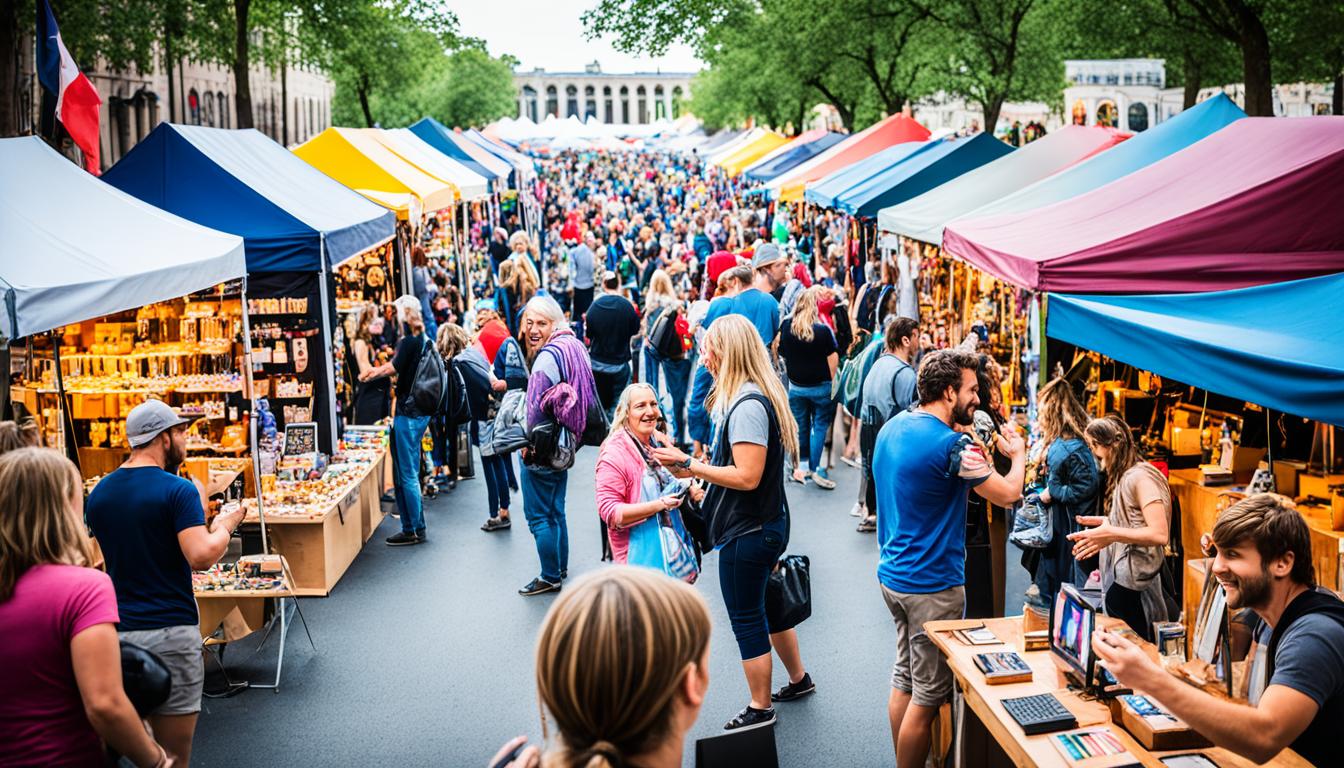
Editorial Team
Staples marketing strategy 2024: a case study, starwood hotels marketing strategy 2024: a case study.
Starbucks Marketing Strategy: How Starbucks became the market leader by 'inspiring and nurturing the human spirit'
Learn about starbucks' iconic marketing strategy and advertising campaigns. read how starbucks aces the 4ps of marketing mix - product, price, promotion & placement..
- overview#goto" data-overview-topic-param="history">Brief history
- overview#goto" data-overview-topic-param="believe">What does Starbucks believe in?
- overview#goto" data-overview-topic-param="giant">A global coffee giant
- overview#goto" data-overview-topic-param="strategy">Starbucks' Marketing Strategy
- overview#goto" data-overview-topic-param="iconic">Iconic Marketing Campaigns
- overview#goto" data-overview-topic-param="regular">Thinking beyond regular coffee
- overview#goto" data-overview-topic-param="key">Key Takeaways

If you were to think of coffee, wouldn’t the classic siren logo printed Starbucks cup be the first thing to pop up in your mind? Starbucks is one of the world’s most popular and successful premium coffee brands. It is known for its premium coffee, which is made with fresh ingredients roasted in the Starbucks store every day.
Starbucks is an American multinational coffeehouse chain founded in 1985 and operates in around 80 markets! Starbucks has a whopping 36.7% market share in the United States alone.
You’d likely have a lot of questions now: how did Starbucks coffee manage to become so big? What makes them different from all other mass-market brands?
And most importantly, why is Starbucks the best at what they do? In this case study, we will dive into various aspects of Starbucks' marketing strategy.
A brief history of Starbucks
Starbucks was founded by three men — Jerry Baldwin, Zev Siegl, and Gordon Browker. The trio’s love for coffee and tea was something they had in common.
They drew inspiration from Peet’s Coffee and Tea, a small beverage store founded by a Dutch immigrant. Peet used first-grade coffee and tea beans. Its success cheered the Starbucks founders’ to start one on their own. That’s when, in 1971, they started their first store in Seattle. They named their new business Starbucks, after a fictional character in the Moby-Dick novel.
In the early 1980s, they already opened four stores in Seattle and outranked their competitors. However, at the same time, Siegl decided to part ways to pursue other interests and this led to Starbucks’ struggle for a brief period.
But, in 1984, things began to change for the better when Howard Schultz joined the marketing team as its Director. Schultz had a vision for Starbucks beyond just selling coffee and coffee beans. He wanted to create a unique customer experience that appealed to coffee lovers everywhere.
Schultz's vision came to fruition in 1987 when Starbucks opened its first store outside of Seattle. This marked the beginning of the company's explosive growth. By 1992, there were more than 400 Starbucks stores nationwide.
Going Global
In 1995, Schultz decided to take Starbucks international and opened its first store in Tokyo, Japan. Over the next few years, he opened additional stores in countries all around the world including China, Australia, Italy, Germany, and France.
Today, there are more than 32,000 Starbucks stores in 80 different countries.

What does Starbucks believe in?
Starbucks’ corporate mission is -
“to inspire and nurture the human spirit – one person, one cup, and one neighborhood at a time.”
This statement emphasizes Starbucks’ dedication to providing customer engagement and customer satisfaction.
Also, Starbucks believed that it should be more than just selling coffee and about creating a community space where people can gather and socialize. This sentiment is summed up in its slogan, “The Third Place” and its corporate vision -
"to create moments of connection for everyone who visits our stores."
How Starbucks Became a Global Coffee Giant
As one of the largest chains in the world's coffee market, Starbucks is a company that is always worth taking a closer look at. Now, let’s explore its current business model and pricing strategy.
One thing that sets Starbucks apart from other coffee shops is its focus on customer engagement and experience. From the moment you walk into a store to when you leave, Starbucks employees are there to ensure your experience is perfect. This focus on customer service has helped contribute to the chain's massive success over the years.
But what about its pricing strategy for profits?
Unlike many other consumer chains, Starbucks does not use a discount pricing strategy, and this actually enhances customer perception. That is, it charges exceptional prices for its premium products.
Customers who are willing to pay more for their coffee tend to view it as being of a higher quality. As a result, they perceive Starbucks as a premium coffee brand and are likely to be loyal customers.
While this might be seen as risky by some business owners, its premium pricing strategy has thus far proven to be successful for Starbucks.

So, what makes Starbucks' business model and marketing strategies successful?
Starbucks has always been innovative when it comes to its business model. Rather than just selling coffee, it expanded into food items, drinks, and even music. This means that they can reach a broader customer base, which in turn results in higher customer sales and profits.
Now, the story is no different due to its successful marketing strategies. This keeps the brand exciting and fresh, which helps it stand out from the competition.
There's no denying that Starbucks has a massive success story - but what exactly is the reason behind its successful marketing strategies? Let's take a look at Starbucks' marketing mix:
What is Starbucks' Marketing Strategy?
From the beginning, Starbucks' objective has been to create a "third place" beyond home and work where people can relax and enjoy good coffee.
Starbucks' marketing strategy has been designed to achieve this goal by targeting both regular customers and occasional customers with a consistent brand experience.
In the following sections, let us learn more about its key marketing mix strategies across price, placement, product, and promotion.
1. Starbucks' Promotion
From its very beginning, Starbucks has heavily invested in promotional campaigns. These campaigns include TV commercials, print ads, and radio spots, as well as online marketing brand initiatives such as social media and search engine optimization.
Through its marketing mix, it attracts new customers and keeps the existing ones coming back for more. The premium global coffee brand focused a lot on building customer loyalty and customer retention.
The company sponsors major sporting events such as the Olympics and Wimbledon, and it even partners with other businesses to promote its products.
2. Starbucks' Product
In its early days, Starbucks focused on selling high-quality coffee beans to consumers and businesses. It was not until later that they began to sell brewed coffee beverages. However, today, Starbucks offers a wide variety of drinks and food items, including pastries, sandwiches, and salads.
The company also sells Starbucks coffee beans and brewing equipment to customers who want to make their own coffee at home.
3. Starbucks' Pricing Strategies
One of the factors that have contributed to Starbucks' success is its premium pricing strategy.
To reiterate, Starbucks sets high prices for its products but offers good value for money by providing excellent customer service and a comfortable environment.
That is, it sells coffee at least 25% higher than other value brands and still keeps up a great deal of customer loyalty. However, the chain does offer a few discount programs such as the Starbucks customer rewards program and student beans program at both local and international levels.
4. Starbucks' Placement
Starbucks has placed its stores in strategic locations all over the world. Although it has many brick-and-mortar stores around the world, it also sells its products online through its website and app.
The company has been expanding its delivery services in recent years in order to deliver a good customer experience to its target audience and also reach more customers.
Iconic Marketing Campaigns by Starbucks
Starbucks' marketing campaigns were designed to entice even the ‘I’m not a coffee person’ beyond their natural target audience.
Let's explore some of Starbucks' most innovative marketing tactics that won millions of hearts -
Creative Cup Contests
#thewhitecupcontest.
In 2014, Starbucks ran a promotion called "The White Cup Contest" in which customers were invited to design their own Starbucks coffee cups. The winners would have their designs featured on Starbucks' limited edition products and merchandise.

Source: Consumer Value Creation
#theredcupcontest
Starbucks' red cups became an annual tradition — the symbol of Christmas — and sometimes prompted speculation. Earlier this year they started a #theredcup competition on Instagram. The winner can post a photograph of their RED Cup and use the hashtag theredcupcontest. 40,000 entries collected during the contest were collected on Instagram in 2015.
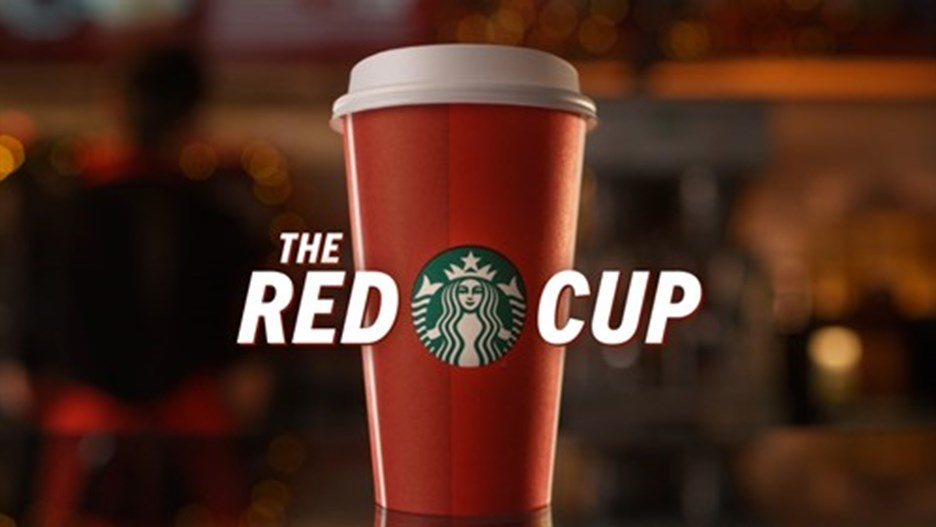
Source: Iris Worldwide
Tweet-a-coffee campaign
Tweet-to-coffee allows people to pay for coffee online by tweeting @tweetoffee and their friends. This link will give them $5 in rewards. The company's Twitter page received nearly 1 billion tweets. During the first two weeks of operation, there were nearly $180,000 in revenues.
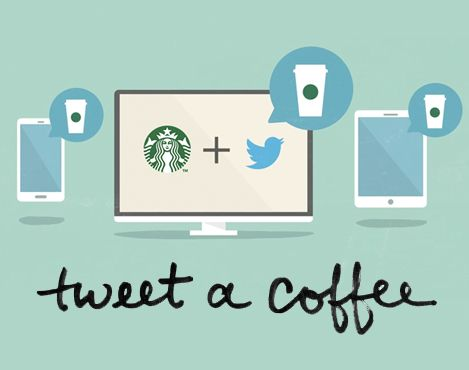
Source: Starbucks Stories
Humans of Starbucks
Starbucks has been on a mission to humanize work for years now. To date, Starbucks is committed to this goal.
To do this, they have launched several initiatives over the years, including their “To Be Human” campaign. It aims to remind employees and customers alike that we are all connected by the shared feeling of humanity.
So far, the “To Be Human” campaign has been implemented in a few different ways. First and foremost, Starbucks has created a series of videos that highlight real-life stories about people connecting over coffee. These videos are being shown in stores all around the world, in an effort to create brand ambassadors organically, and vouch for the importance of connection.
Get into Cause Marketing
Starbucks has also partnered with several charitable organizations like Feeding America and Save The Children UK in order to support causes that align with their beliefs. For example, for every purchase made through their app during December 2018, they donated $1 to one of these charities.
Mobile App and Loyalty Programs
Starbucks knows that retail's future depends in some ways on technology. As another Starbucks marketing strategy, it launched a mobile phone app in 2009 and positioned it in a way that helps customers save time in long queues.
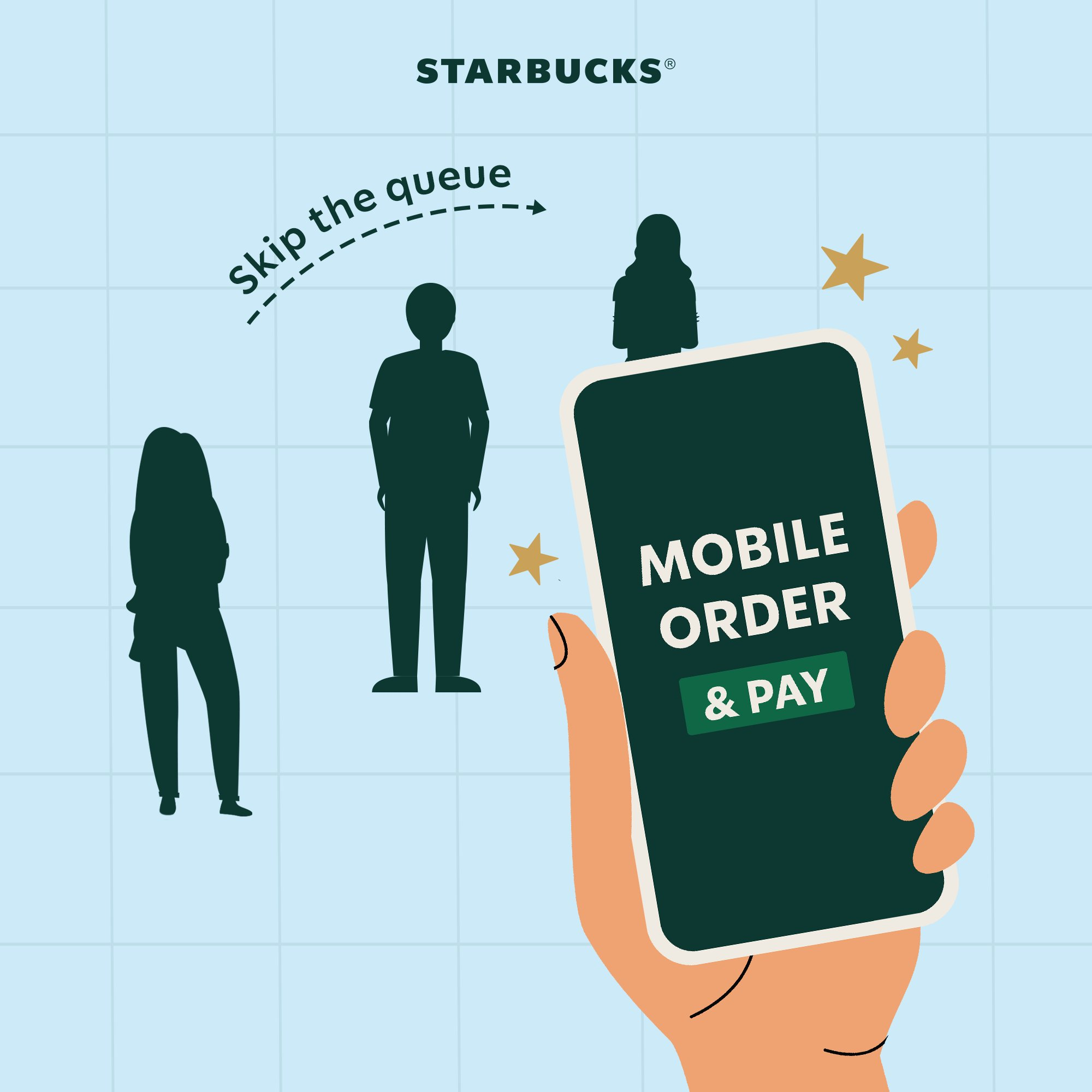
Source: Starbucks Malaysia Twitter
Unlike any other mobile phone app as a business strategy, Starbucks introduced a program on the Starbucks app called 'My Starbucks Rewards' that rewards customers for their continued patronage. In a few seconds, the Starbucks purchases will be rewarded for using the app to pay for their services.
Once they join, they start earning stars for all Starbucks transactions.
On accumulating enough stars, one can redeem them for rewards such as free coffee or free drinks, and food too. Say, for example, you can redeem 12 stars for a free beverage of any size.
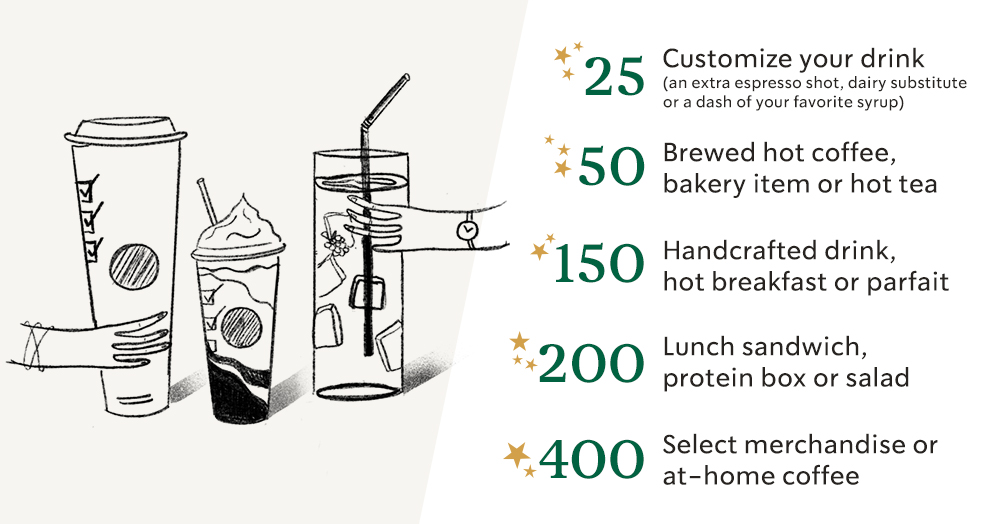
Source: Starbucks
Giving back to society, nature, and itself
Starbucks' ecosystem has a long history of being involved in social responsibility programs. It introduced a comprehensive initiative that focuses on four key areas: environmental stewardship, ethical sourcing, community engagement, and employee well-being.
Environmental stewardship:
One of its primary goals is to reduce its environmental impact by becoming more energy efficient and using less packaging materials.
Some of the things that the Starbucks' ecosystem has done in order to achieve this include installing energy-efficient lighting systems and recycling coffee grounds into biodegradable cups.
Ethical sourcing:
Starbucks takes great care to ensure that its products are ethically sourced. This means that they only work with suppliers who meet their high standards for quality and sustainability.
Starbucks also supports sustainable farming practices through programs like Farmer Equity & Loan Assurance (FELA).
Community Engagement:
Starbucks believes in giving back to the communities where they do business. One way they do this is by partnering with local organizations to help fund literacy and education programs.
They have also created unique scholarship opportunities for employees' children who want to pursue higher education.
Employee Well-being:
Starbucks cares about the well-being of its employees just as much as it cares about the environment or ethical sourcing. This is why they offer health insurance plans, flexible working schedules, and training programs designed to help employees grow professionally.
In-store Marketing
While there are many different aspects to Starbucks’ marketing strategy introduced in-store, all of them revolve around one common goal – enticing customers inside the store so they can be sold on the brand!
Starbucks is a prime example of a company that uses in-store marketing to great effect. Their marketing mix includes a variety of elements, such as
Store Layout: The layout of Starbucks stores is very carefully planned out in order to create an inviting environment. It has comfortable seating areas with counters where people can not only drink coffee, but also work or study.
Starbucks also started giving its customers free Wi-Fi in 2002. This encouraged customers to stay longer even after making purchases. Alongside, it attracted working professionals to engage in business or lunch meetings at the outlet all day long!
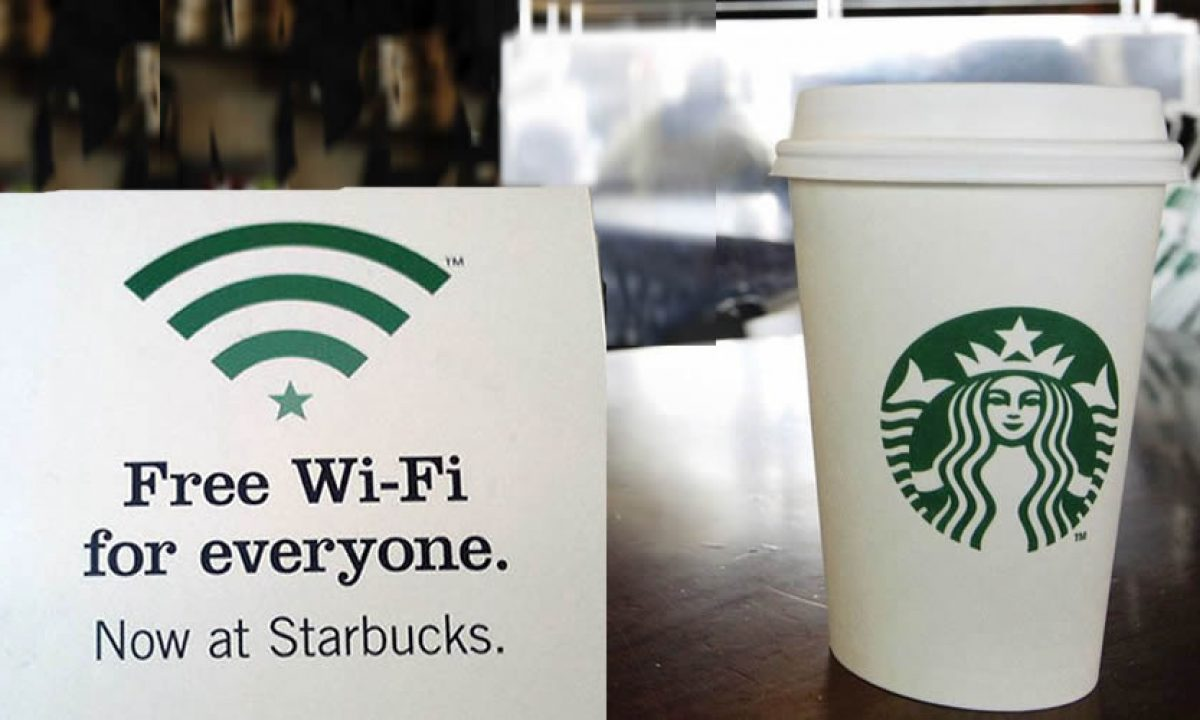
Source: Tech Log
Product Displays: The products on display at Starbucks are always well organized. This makes it easy for customers to find what they’re looking for and helps them make quick purchase decisions. And, it is so well arranged that it helps with impulsive purchases, just like how you do in supermarkets!
Promotions: Starbucks runs frequent promotions throughout the year in order to attract more customers. These vary from discounts on coffee drinks to freebies like pastries or stickers.
Thinking beyond regular coffee
Starbucks’ success is attributed to its willingness in experimenting with new products and services. For example, they were one of the first companies to offer premium coffee drinks like latte and mocha.
Also, Starbucks launched an instant coffee line called Via which was a big hit among consumers.
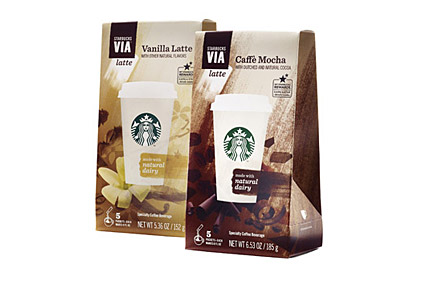
Source: Dairy Foods Magazine
By constantly innovating and expanding its product lineup, Starbucks has been able to elevate its customer experience and stay ahead of the competition.
How Starbucks’ marketing strategy makes you hungry?
Starbucks is undeniably one of the most successful coffee chains in the world. But what sets them apart from other coffee shops? The answer is Starbucks' competitive marketing strategy, once again.
Starbucks uses various marketing tactics to make us all crave its coffee, and one of the most effective methods is by making us hungry. But how? Here, we go.
Appetizing Colors: By far, the human tendency has always been to stay healthy and inclined towards nutritious food. The general Starbucks appeal is created through consistent branding with the green color in Starbucks’ brand instantly reminding one of the natural ingredients. This free marketing pull encourages us to eat more, which then leads to us wanting caffeine for energy.
Aroma Marketing:
One of the other main reasons we get hungry at the store is because of the aroma that Starbucks sells. The premium Starbucks coffee tastes are owed to the freshly roasted coffee beans every day.
This creates a Pavlovian response where we start to salivate as soon as we catch a whiff of those delicious aromas.
Key Takeaways from Starbucks for Entrepreneurs
If you're an entrepreneur fascinated by the beverage industry, here are some major takeaways from Starbucks' marketing strategy and its business-
Focus on the Customer: The first lesson is to always focus on the customer. This means putting their needs and wants first and making sure they are happy with your product or service.
Keep Things Simple: Consistent Starbucks' branding and its simple operations helped them become successful worldwide. As an entrepreneur, it's important to maintain consistent branding and keep your business simple and streamlined. This will make it easier to manage and less likely to run into problems down the road.
Be Innovative: Starbucks is constantly innovating and coming up with new products and services that appeal to its customers’ tastes. You should try to adopt innovative and new ways to improve your business.
Offer Unique Products: Another reason for Starbucks' global brand success is its unique and premium coffee products. The company offers a wide range of products that cater to different tastes, which helps to attract new customers and lure the existing ones to come back for more.
- popover#mouseOver mouseout->popover#mouseOut" data-popover-translate-x="-25%" , data-popover-translate-y="-220%"> Copy link
- bottom-bar#toggleTagsSection"> popover#mouseOver mouseout->popover#mouseOut" data-popover-translate-x="-25%" , data-popover-translate-y="-220%"> Copy Link
- bottom-bar#toggleTagsSection">
Test your knowledge through a fun quiz!

"Must read for every entrepreneur"

"The best part is it's written by real entrepreneurs"

"My favorite newsletter on the web"
You'll love these articles too!

Co-founder at Flexiple, buildd & Remote Tools ($3 million revenue, bootstrapped)
Breaking Down The Maruti Suzuki Marketing Strategy: How they became a brand that rules India's automobile market
Learn about Maruti Suzuki's iconic marketing strategy and advertising campaigns. Read how Maruti Suzuki's aces the 4Ps of marketing mix - Product, Price, Promotion & Placement.

Clinical Research | Data Analytics

Partner at Deloitte | Banking & Capital Markets | Cloud Strategy | FinOps Offering Leader | Board...

Co-founder & CEO at Flexiple ($3mn+ revenue, bootstrapped) & buildd.co | Helping Startup...
Swiggy Business Model: How the Company is Building a Brand That's Hard to Resist
Explore the innovative business strategies behind Swiggy's success, including the company's approach to building a strong brand and delivering unbeatable customer experiences. Learn how Swiggy is disrupting the food delivery industry and solidifying its place as a leader in the market.

Market Penetration Definition, Rate Calculation Examples and Strategies
Learn all you need to know about market penetration. Find the market penetration definition, how to calculate it, examples and strategies.

BE Mechatronics |

Hi! My name is Uche, a Nigerian and undergraduate degree student at Brigham Young University (...
Starbucks Marketing Strategy Unveiled | A Case Study
Jane Ng • 31 Oct 2023 • 5 min read
Are you curious about Starbucks marketing strategy? This global coffeehouse chain has transformed the way we consume coffee, with a marketing approach that’s nothing short of genius. In this article, we’ll dive deep into Starbucks marketing strategy, exploring its core elements, the 4 Ps of Starbucks’ Marketing Mix, and its success stories.
Table Of Contents
What is starbucks marketing strategy, key components of starbucks marketing strategy, the 4 ps of starbucks’ marketing mix, starbucks marketing success stories, key takeaways.
- FAQs About Starbucks Marketing Strategy
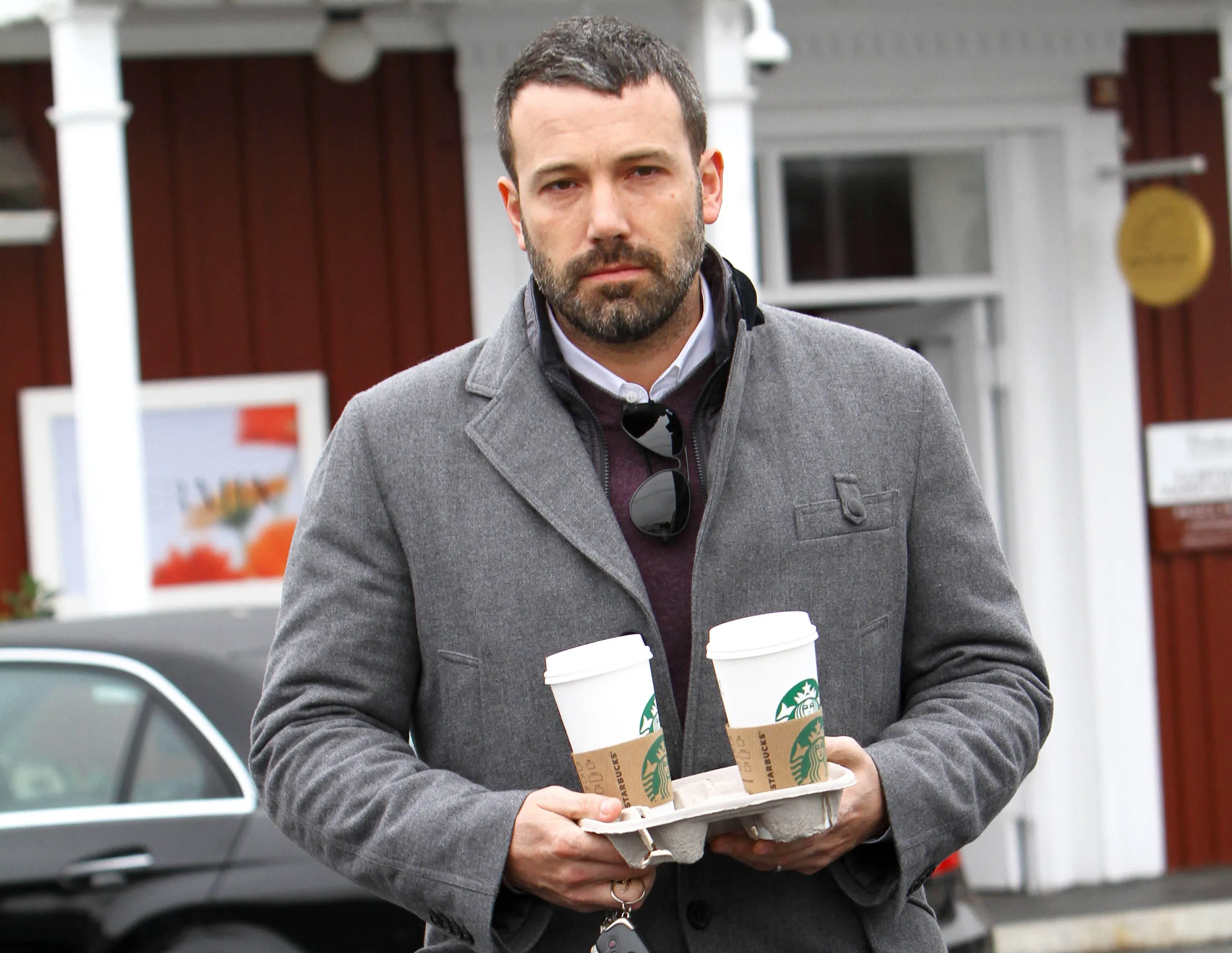
Starbucks marketing strategy is all about creating exceptional experiences for its customers. They do this by:
Starbucks’ Core Business Level Strategy
Starbucks is unique in the coffee world because it doesn’t just compete on price. Instead, it stands out by making special and high-quality products. They always aim for something new and innovative, which makes them different from others.
Starbucks Global Expansion Strategy
As Starbucks grows all over the world, it doesn’t use a one-size-fits-all approach. In places like India, China, or Vietnam, they change things up to suit what people there like while keeping the Starbucks style.
1/ Uniqueness and Product Innovation
Starbucks focuses on offering unique products and constant innovation.
- Example: Starbucks’ seasonal drinks like the Pumpkin Spice Latte and the Unicorn Frappuccino are excellent illustrations of product innovation. These limited-time offerings generate excitement and draw in customers seeking something different.
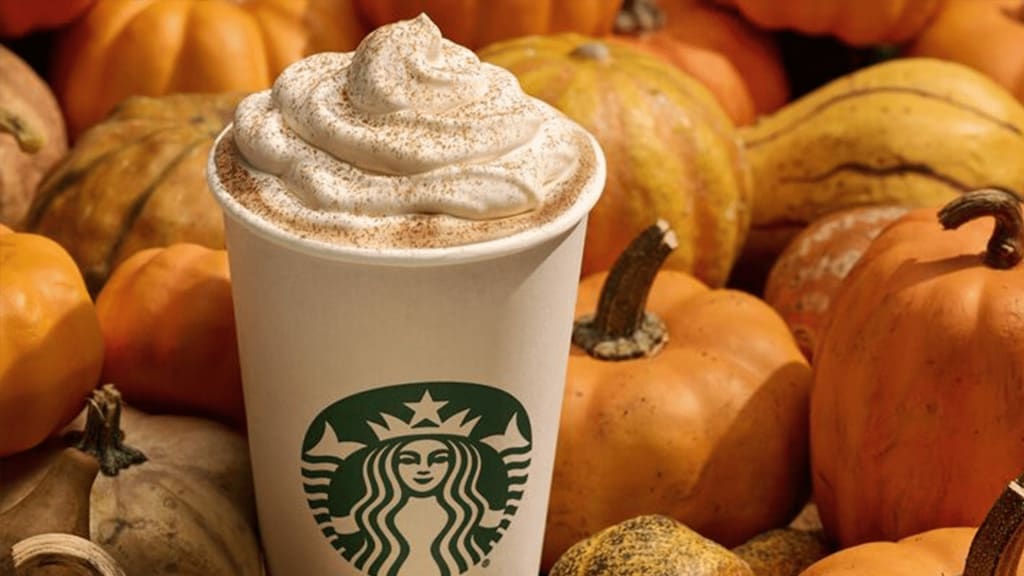
2/ Global Localization
Starbucks adapts its offerings to cater to local tastes while maintaining its core brand identity.
- Example: In China, Starbucks introduced a range of tea-based beverages and mooncakes for the Mid-Autumn Festival , respecting local traditions while keeping the Starbucks experience intact.
3/ Digital Engagement
Starbucks embraces digital channels to enhance customer experiences.
- Example: The Starbucks mobile app is a prime example of digital engagement. Customers can order and pay through the app, earning rewards and receiving personalized offers, simplifying and enriching their visits.
4/ Personalization and the “Name-on-Cup” Strategy
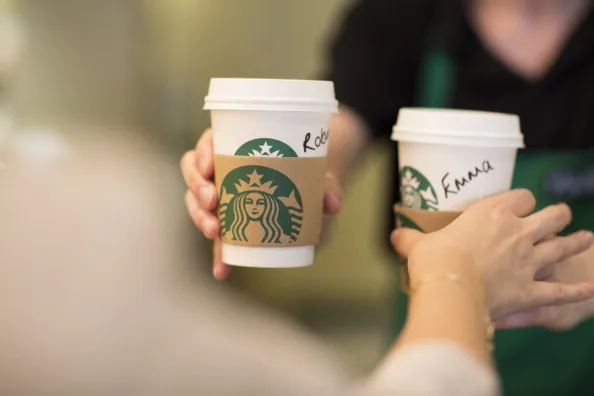
Starbucks connects with customers on a personal level through the famous “ name-on-cup ” approach.
- Example : When Starbucks baristas misspell customers’ names or write messages on cups, it often results in customers sharing their unique cups on social media. This user-generated content showcases personal connections and serves as free, authentic promotion for the brand.
5/ Sustainability and Ethical Sourcing
Starbucks promotes ethical sourcing and sustainability.
- Example: Starbucks’ commitment to buying coffee beans from ethical and sustainable sources is evident through initiatives like C.A.F.E. Practices (Coffee and Farmer Equity) . This reinforces the brand’s commitment to environmental and social responsibility, attracting customers who value sustainability.
Product Strategy
Starbucks offers an array of products, not just coffee. From specialty beverages to snacks, including specialty beverages (e.g., Caramel Macchiato, Flat White), pastries, sandwiches, and even branded merchandise (mugs, tumblers, and coffee beans). Starbucks caters to a wide range of customer preferences. The company continually innovates and customizes its product offerings to maintain a competitive edge.
Price Strategy
Starbucks positions itself as a premium coffee brand. Their pricing strategy reflects this position, charging higher prices compared to many competitors. However, they also offer value through their loyalty program, which rewards customers with free drinks and discounts, promoting customer retention and attracting price-conscious consumers.
Place (Distribution) Strategy
Starbucks’ global network of coffee shops and partnerships with supermarkets and businesses ensures the brand is accessible and convenient for customers. It’s not just a coffee shop; it’s a lifestyle choice.
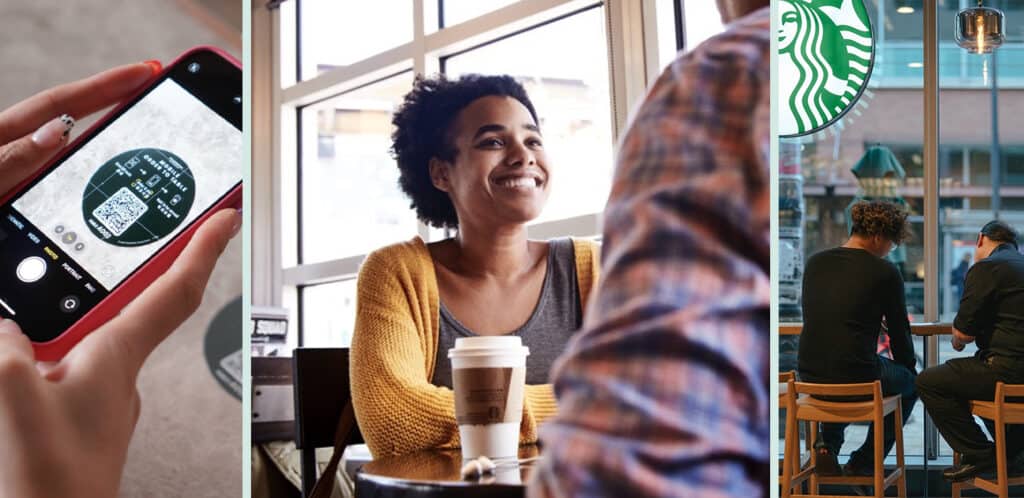
Promotion Strategy
Starbucks excels in promotion through various methods, including seasonal advertising campaigns, social media engagement, and limited-time offerings. Their holiday promotions, such as the “ Red Cup ” campaign, create anticipation and excitement among customers, increasing footfall and sales.
1/ The Starbucks Mobile App
Starbucks’ mobile app has been a game-changer in the coffee industry. This app seamlessly integrates into the customer experience, allowing users to place orders, make payments, and earn rewards all within a few taps. The convenience offered by the app keeps customers engaged and encourages repeat visits.
Additionally, the app is a data goldmine, providing Starbucks with insights into customer preferences and behaviors, enabling more personalized marketing.
2/ Seasonal and Limited-Time Offerings
Starbucks has mastered the art of creating anticipation and excitement with its seasonal and limited-time offerings. Examples like the Pumpkin Spice Latte (PSL) and the Unicorn Frappuccino have become cultural phenomena. The launch of these unique, time-limited drinks creates a buzz that extends beyond coffee enthusiasts to a broader audience.
Customers eagerly await the return of these offerings, turning seasonal marketing into a potent force for customer retention and acquisition.
3/ My Starbucks Rewards
Starbucks’ My Starbucks Rewards program is a model of loyalty program success. It puts the customer at the center of the Starbucks experience. It offers a tiered system where customers can earn stars for each purchase. These stars translate into various rewards, from free drinks to personalized offers, creating a sense of value for regular patrons. It boosts customer retention, elevates sales, and cultivates brand loyalty.
In addition, it enhances the emotional connection between the brand and its customers. Through personalized offers and birthday rewards, Starbucks makes its customers feel valued and appreciated. This emotional bond encourages not only repeat business but also positive word-of-mouth marketing.
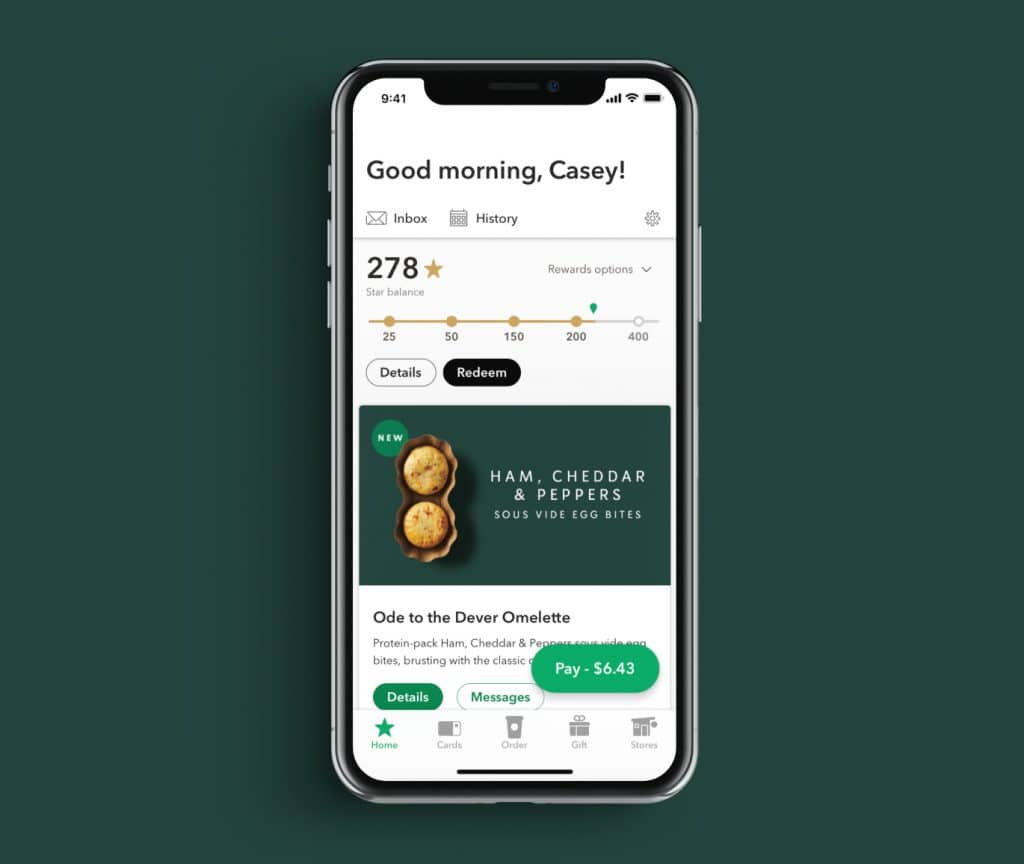
Starbucks marketing strategy is a testament to the power of creating memorable customer experiences. By emphasizing uniqueness, sustainability, personalization, and embracing digital innovations, Starbucks has solidified its position as a global brand that extends far beyond coffee.
To enhance your own business’s marketing strategy, consider incorporating AhaSlides. AhaSlides offers interactive features that can engage and connect with your audience in novel ways. By harnessing the power of AhaSlides, you can gather valuable insights, personalize your marketing efforts, and cultivate stronger customer loyalty.
FAQs About Starbucks Marketing Strategy
What is the marketing strategy of starbucks.
Starbucks’ marketing strategy is built on delivering unique customer experiences, embracing digital innovation, ensuring product quality, and promoting sustainability.
What is Starbucks most successful marketing strategy?
Starbucks’ most successful marketing strategy is personalization through its “name-on-cup” approach, engaging customers and creating social media buzz.
What are the 4 P’s of marketing Starbucks?
Starbucks’ marketing mix consists of Product (diverse offerings beyond coffee), Price (premium pricing with loyalty programs), Place (global network of stores and partnerships), and Promotion (creative campaigns and seasonal offerings).
References: CoSchedule | IIMSkills | Mageplaza | MarketingStrategy.com

A writer who wants to create practical and valuable content for the audience
More from AhaSlides

Table of Contents
What is the starbucks target market, the rewarding marketing strategies of starbucks, marketing mix, how strong is the starbucks digital marketing presence, marketing during covid-19, starbucks’ strategic alliances that enhanced their reach , exploring starbucks marketing strategy: the success secret.
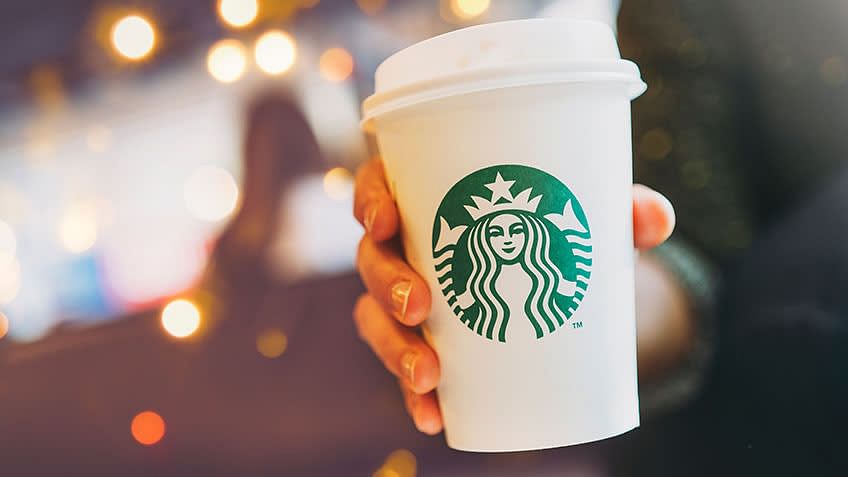
Ranking 5th on the World's Most Admired Companies list by Fortune, the commitment to consistent branding has made Starbucks a huge success today. Spanning 70 countries worldwide, this American multinational chain of coffeehouses has come a long way in its journey. The Starbucks marketing strategy constitutes a blend of social media marketing , digital marketing , search engine optimization , and right post-marketing analysis.
Replicating the entire Starbucks marketing strategy is nearly impossible for brands with low budgets. However, learning and implementing the core principles and the idea behind the Starbucks marketing strategy can benefit even startups.
Earn the Esteemed Purdue Certification
By knowing exactly who its target audience is at any point and catering to a specific set of people, Starbucks has been able to stand apart from its competitors like Costa and Cafe Coffee Day.
Being a premium coffee brand, Starbucks has most of its customers belonging to the upper economic segment. It targets youngsters and people who seek a peaceful space to drink coffee. Its high-end customers fall in the 22-50 age group, both male and female. Thus, the Starbucks target market constitutes:
- High-income spenders
- Health-conscious professionals
- Technology early adopters
- Coffee-addict youngsters
The Starbucks marketing mix segments its customers on a socio-economic level. The distinguished offline experience and consistent online marketing efforts have made the brand exceptional.
Starbucks' marketing mix very well incorporates the four P's .
- Product: High-quality products justify the premium pricing. They ensure that the coffee tastes better than its competitors. Their Barista Promise of fixing your drink if you don't like it has attracted the masses.
- Price: Starbucks sells their coffee at least 25% higher than other brands. It offers its customers exceptional drinks and food, charges more, and the people are willing to pay.
- Promotion: From social media to TV to ads– the company uses various channels for marketing its products. The mix of marketing media makes them stand out. Compared to other major global brands like Apple, Starbucks spends the least on their marketing but can still make an impact. Why? The robust Starbucks marketing strategy has made all the difference.
- Place: They create a similar premium relaxing environment in every Starbucks location which lures the crowd.
Key Takeaway: Your brand can charge a higher price by providing a premium experience and delivering better products than the competitors.
Digital Expansion
The Starbucks marketing strategy incorporates digital interactions with customers by implementing new ways to attract digitally registered customers. It offers mobile order services and Wi-Fi sign-ins at its stores. The ability to go cashless with Starbucks cards has further accelerated its business.
Starbucks Social Media Strategy
Starbucks' social media accounts exhibit distinctive branding , visually appealing content, and interactive posts that enhance user engagement. The diverse content range has eye-catching photography, videos, recipes, articles and more. In addition to the visual appeal, the Starbuck marketing strategy for social media breaks down the stream of content into a series of campaigns.
Become a Certified Marketing Expert in 8 Months
Starbucks Campaigns
The Starbucks campaigns fall into the following three categories, creating a greater sense of brand awareness :
- Starbucks Product-based Campaigns: The company promotes unique and fan-favorite beverages. It has even created social profiles for customers' favorites -Frappuccino and Pumpkin Spiced Latte. They publish relevant memes for their audience. Utilizing the power and sentiments attached to consumer images, the brand often re-shares them on its official channels.
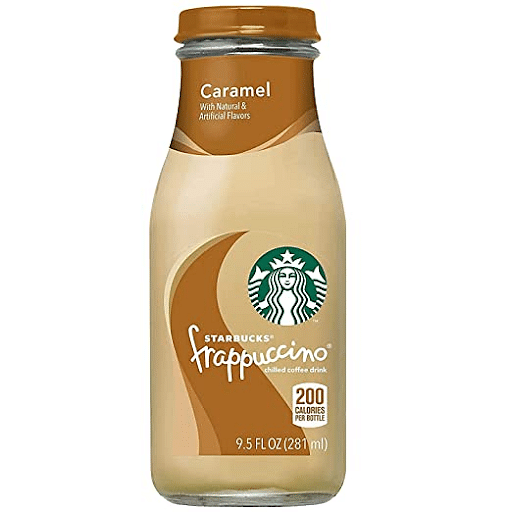
Starbucks Frappuccino
- Starbucks Corporate Social Responsibility-Based Campaign: Using social change as a marketing tool, Starbucks positions itself as inclusive and open-minded. Its #The ExtraShotOfPride campaign gained popularity by supporting the LGBT+ community.
- Community-based campaigns: Another important facet of the Starbucks marketing strategy is its emphasis on highlighting communities and individuals. They rely on storytelling to depict acts of kindness in communities while localizing the content.
Festive Marketing
Innovative ideas have been the strength of Starbucks. The company initiated a whole-bean coffee campaign– #StarbucksDiwaliBlend as a tribute to Karnataka's rich coffee heritage and expertise.
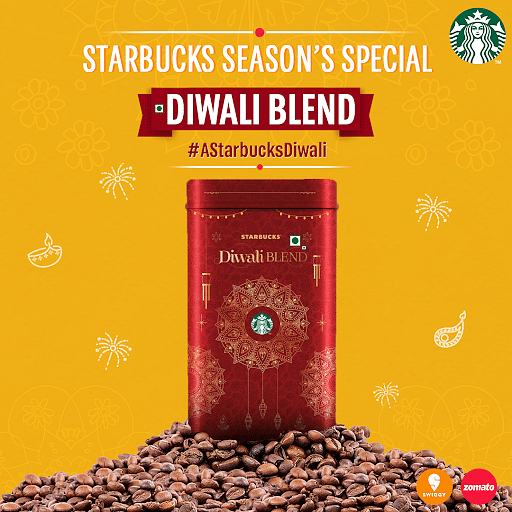
Starbucks Diwali Blend
Its #SketchTheBlend campaign was launched on Diwali, where customers were urged to share their creativity on the Diwali Blend cup. The best ones could bag five free beverages.
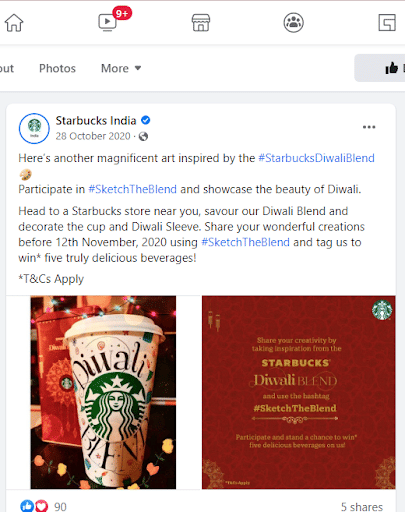
Starbucks Facebook Post on #SketchTheBlend
Key Takeaway: Involving customers via festive marketing is a strong part of the Starbucks marketing strategy too. You can also leverage the opportunity and enhance customer engagement.
Targeting the elite class, Starbucks understands that its audience is technologically advanced. Starbucks' digital marketing provides it with an opportunity for two-way communication, unlike leaflets, magazines, and television, which are more of one-way communication. It has considerable traffic on its social media accounts, including
- Facebook: 36 M+ page likes
- Instagram: 17.8 M followers
- Twitter: 11 M followers
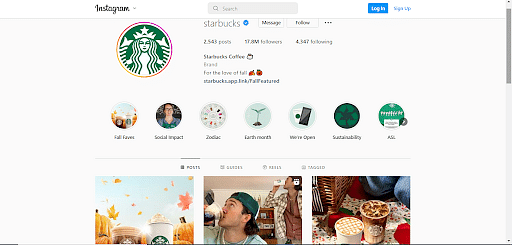
Starbucks Instagram Handle
Consistency is the key to a successful Starbucks marketing strategy. It extends the same to social media handles by posting daily. It has challenges and games that engage its customers and enhance its fan base.
Also, the company publishes engaging posts and connects viewers from one platform to another. Take the following Instagram post as an example. The bright and clean picture is reflective of the Starbucks brand. The caption describes their new espresso shot in a conversational tone.
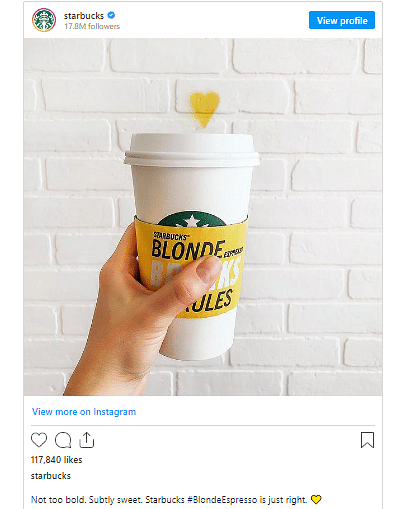
Starbucks Instagram post
Now any consumer interested in the product would probably like to know more and find the landing page for Starbucks’ blonde espresso .
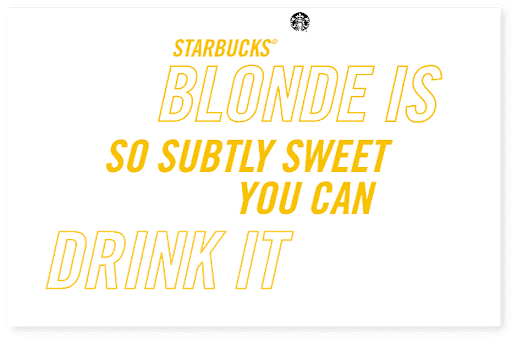
Starbucks Website Image for Blonde Espresso
The website satisfies the intrigued customer with more information on the blonde espresso and why Starbucks has launched the same. Scrolling down, you would come across videos and several other images. Thus, the company smartly employs marketing tactics to lure its customers and delight them with amazing products.
As the Covid-19 pandemic took over the world, Starbucks geared up with marketing tactics to sustain itself in these unprecedented times. The company constantly improvised, mitigating the economic impact via the following measures:
- Expansion: Starbucks announced launching drive-thrus and home delivery to stay connected with their customers in tough times. They also launched their app in India to help customers easily navigate and purchase their key offerings.
- Starbucks Social Media Campaigns: Seizing the opportunity to expand its user engagement, the company launched the #ReconnectWithStarbucks campaign. They asked their followers to share ideas of reconnecting amidst the pandemic. They also urged them to share their favorite Starbucks memory via Instagram with the hashtag #ReconnectWithStarbucks. Another popular campaign was the “Half Cup Full”. The customers had to comment on their favorite beverage on the Starbucks post, and then to remind the customers of the in-store experience, they sent them voice notes of baristas calling their names along with their favorite beverage.
As a part of the Starbucks marketing strategy, the company makes smart associations that enhance its reach and experience.
Merchandise Launch With Flipkart
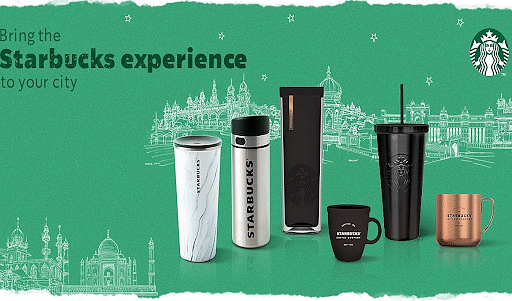
Starbucks Merchandise Launch with Flipkart
Taking advantage of the growing dependence on e-commerce during the pandemic, Starbucks partnered with Flipkart and launched Starbucks Signature Merchandise on the platform. It offered a range of products, including custom mugs, cold cups, tumblers, coffee brewing equipment and more. Thus, enabling its customers to order from the comfort of their homes.
A well-crafted Starbucks marketing strategy is one of the prime reasons why the coffee-chain company has a dominating global presence and leadership. Additionally, to stay true to its word, they provide an arguably different atmosphere, unmatched service, and a welcoming environment to every customer who visits their brick-and-mortar stores.
You can establish your business with a stellar marketing strategy and employ the best digital marketing practices. Start your journey in upskilling yourself by enrolling on Simplearn’s PCP Digital Maketing Program in collabration with Purdue University. Boost your career with a unique 6-month course and a placement guarantee.
Our Digital Marketing Courses Duration And Fees
Digital Marketing Courses typically range from a few weeks to several months, with fees varying based on program and institution.
Recommended Reads
Digital Marketing Career Guide: A Playbook to Becoming a Digital Marketing Specialist
Walmart Marketing Strategy
12 Powerful Instagram Marketing Strategies To Follow in 2021
Introductory Digital Marketing Guide
A Case Study on Netflix Marketing Strategy
What is Digital Marketing and How Does It Work?
Get Affiliated Certifications with Live Class programs
Post graduate program in digital marketing.
- Joint Purdue-Simplilearn Digital Marketer Certificate
- Become eligible to be part of the Purdue University Alumni Association
IMT Ghaziabad Digital Marketing Program
- Digital Marketing certificate from IMT Ghaziabad
- IMT Ghaziabad Associate Alumni status
- PMP, PMI, PMBOK, CAPM, PgMP, PfMP, ACP, PBA, RMP, SP, and OPM3 are registered marks of the Project Management Institute, Inc.

Strategy Studies
Starbucks marketing strategy — it’s genius.
Home > Back
Specialties

Starbucks is undoubtedly one of the world’s most identifiable brands – exhibiting an innovative and fresh approach to their brand and marketing strategy. The Starbucks Marketing Strategy has helped their brand reach epic heights thanks to their out-of-the-box campaigns and unmatchable commitment towards keeping their quality and brand consistency across multiple touchpoints and locations.
Not many brands globally have the ability to produce humongous marketing budgets like Starbucks, so replicating its marketing strategies at the same level is nearly impossible. However, a few core principles behind the Starbucks marketing strategy can be adapted and implemented by almost any brand.
In this post, we’ll cover the entire journey of Starbucks’ marketing strategy of building one of the biggest brands in the world. We’ll also go through the tactics they are currently using to continue to meet their customer’s (high) expectations and keep their legacy intact. Plus, we’ll cover a slew of actionable takeaways you can use to implement similar marketing strategies and basic branding principles into your business.
Here’s what we have covered:
- Introduction – Mapping the marketing strategy journey
- Industry overview and analysis
- Mission and ideology
- Zooming on the target audience
- The classic siren logo
- What defines Starbucks’ marketing strategy – aligning with the four P’s
- Building the brand
- Best marketing campaigns – the brightest shining stars
- Worst marketing campaigns – the regrets
What the future holds
Introduction – mapping the starbucks marketing strategy journey.
Starbucks Corporation is an American company, founded in 1971, based out of Seattle, WA, is the brainchild of stalwarts – Jerry Baldwin, Zev Siegl, and Gordon Bowker. They started their journey by selling coffee beans. Selling premium coffee drinks it’s famous for now was a far-away dream back then.
Today, they have around 182,000+ employees across 19,767+ outlets and licensed stores in over 62 countries. Their products include roasted and handcrafted high quality/premium-priced coffee , tea, and a variety of fresh food items and other experimental flavored beverages.
In 1986, the original owners (Jerry Baldwin, Zev Siegl, and Gordon Bowker) sold Starbucks to Howard Schultz, its former manager. After that, Howard Schultz took over the brand with his transformational vision and built it into today’s coffee behemoth with a net worth of US$3.59 billion.
Industry Overview and Analysis
Starbucks primarily operates and competes with all the comparatively retail coffee and snack joints like Dunkin’ Donuts and Aroma Joe’s. Due to the recent global economic crisis and industry-wide revenue decline in the US, the brand took a major hit of around 6.6% decrease in revenue this year, amounting to $25.9 billion. Before this, the industry experienced comparatively consistent growth. Due to the economic crises, consumers spent less on luxurious things like eating and drinking out, choosing to purchase low-price items instead of high-priced products. And, this hard-truth of the industry showed Starbucks its lowest drops.
The industry is now expected to grow at an annualized rate of 3.7% in the next five years, pulling the revenues up by a whopping $35.1 billion in the US. This growth is primarily driven by an improving economy and an increase in consumer confidence. The market is dominated by Starbucks with market share of 35.7%, followed by Dunkin Brands with 23.6%, and other competitors like McDonald’s, Costa Coffee, Tim Horton’s, sharing the rest of the pie.
Mission and Ideology
Starbucks has completely transformed its brand image from being just another bean roaster in the 1970s to the world’s leading coffee-inspired drink shop. The original vision of Starbucks is well-reflected in its initial mission statement stating:
“Establish Starbucks as the premier purveyor of the finest coffee in the world while maintaining our uncompromising principles while we grow.”
After Howard Schultz bought the company in 1987 from its founding members, he has focused on creating Starbucks as “the third place” . The idea of making that third place is one that exists between work and home, a place of comfort and solace. And, this idea of the “third place” formed the basis of Starbucks new mission statement:
“To inspire and nurture the human spirit – one person, one cup, and one neighborhood at a time.” The central ideology that drives Starbucks’ success is to create a comfort zone and a personal connection between the customers, the baristas, and the brand.
Targeting Their Audience
As the company mission seems self-explanatory, Starbucks is genuinely all about connecting with their customers. And, here is one of the most critical marketing strategy questions – who are the right customers?
According to their research report in 2017, Starbucks’ target audience is middle-aged men and women who have apparently higher purchasing power. So, the big riddle that needs solving is how they convince their customers to fork over that kind of cash rather than just brew coffee at home or move to a more affordable coffee house?
According to Starbucks, they focus ruthlessly on delivering a remarkable and consistent customer-centric approach, offering unforgettable experience every time customers walk into their stores. By focusing on the “third place” theory, they give their customers a place to interact freely, assuring the most premium customer experience that justifies the drink price.
Customers report an affinity for ordering a good coffee cup and sitting in the shop with their laptops. That’s what defines Starbucks’ Stay as long as you want marketing strategy.
The beauty of all Starbucks’ marketing strategy and branding is “consistency” – both with their vision and their target audience. As a universally recognized brand, Starbucks has definitely defined how it wants to be viewed by its customers globally. Their consistent vision spans across every message they send, every piece of branded collateral they create, and every aspect of their in-store design and experience.
The Classic Siren Logo
To understand Starbucks’ marketing strategy, we must first look at Starbucks’ branding ideology. Let’s start with their logo. Over the last five decades, the Starbucks logo has gone through only four redesigns to create the iconic symbol that graces your exotic coffee cups today.
Though, looking at the geographically diverse customer base, redesigning the logo is no way easy. By operating in 60+ different countries, it is challenging for them to appeal to their existing audience base – so logo remains the primary factor of connection and recognition.
The original logo was first created in 1971.

The original logo pulled heavily from the brown palette which is thought to stimulate the appetite. The essence of the logo we know so well today was present believe it or not in the original logo seen here from all those years ago. The Starbucks name is attractively wrapped around the circle, the siren is in a similar position and pose, and the font screams Starbucks even from the first iteration.
In 1987, shortly after the buyout led by Schultz, the Starbucks logo underwent its first re-imagination by designer and original sketch artist, Terry Heckler.

“To symbolize the melding of the two companies [Il Giornale and Starbucks] and two cultures, Terry [Heckler] came up with a design that merged the two logos. We kept the Starbucks siren with her starred crown, but made her more contemporary. We dropped the tradition-bound brown, and changed [Starbucks] logo’s color to Il Giornarle’s more affirming green.” – excerpt from Howard Schultz’s book “Pour Your Heart Into It: How Starbucks Built a Company One Cup at a Time”

“As a team we were like, ‘There’s something not working here, what is it?’ It was like, ‘Oh, we need to step back and put some of that humanity back in. The imperfection was important to making her really successful as a mark.” – Connie Birdsall, Global Creative Director.
Ultimately, the day was a triumph for minimalism as the new logo dropped the Starbucks Coffee name entirely and bathed the now well-known siren brand mark in kelly green. Simple, elegant, and still used as the main logo today.
Everything looks, sounds, and feels like Starbucks – even the basic coffee cup. The Starbucks experience is consistent whether you’re at your home, reading social media posts, watching tv ads, or interacting with their brand in any way, anywhere. And, a significant factor behind this is their “legendary siren logo.”
What Defines The Starbucks Marketing Strategy- Aligning with the four P’s
Starbucks is no doubt expertly acing the four P’s throughout their marketing mix. Let’s dive in to see how they pull it off:
Starbucks’ product provides high-quality coffee and ambiance to justify its pricing to their target audience. As the customers pay for premium coffees, they need to create the “differentiation,” assuring that it tastes better than any other brands like Macdonald’s, barista, etc. Essentially, Starbucks is taking a prestige approach to their overall product marketing strategy offering the best in the industry products.
They promise to craft high-quality premium cups with perfection every time to ensure that the customers never turn away or move to some other competitor.
This is a time-tested marketing strategy that will strengthen brand positioning and affinity over the long-term.
In 1990 Starbucks sold their coffees at a premium price which is 25% higher than other brands, because of this only 4% of their expected sales were achieved in the US. But by 2000, the sales increased exponentially by around 40%, and this was majorly due to “The Starbucks Effect,” as confirmed by the Harvard Business Review. This essentially was a study tying the location of Starbucks stores to higher home values. Prestige pricing not only helps them uphold their promise of quality, but also caters directly to their ideal customer’s lifestyle choices.
<image>
Breakdown of the profit per latte sold. | Source
By offering customers exceptional drinks, snacks and other beverages, Starbucks has changed the entire game. How? Simply because people were willing to pay for it.
Starbucks uses diverse platforms and channels to market/promote its brand and launch new products, including social media, TV spots, and ads. The mix of marketing media makes their brand recognizable, and its consistency makes it more recognizable compared to other coffee brands, which helps them stand out in consumer’s minds.
Promotion isn’t cheap. However, compared to the other brands like Apple and Nike, Starbucks spends significantly less on its marketing/promotions. But they still create an impact.
Read anything about Starbucks; they always boast about creating “the third place” . The idea of creating that third place is to build a comfort zone between work and home.
They never compromise on this, replicating the same environment and ambiance in each store.
Building the Starbucks Marketing Strategy With Brand
Content is the king that defines the blood of every brand. So, Starbucks’ content exhibits its dedication to consistency and innovation. Every piece of content published, follows the same visual and language patterns, following a set of guidelines that are easy for their customers to understand.
Take a look at a few examples to analyze the “Starbucks vibe.”
The Best Starbucks Marketing Strategy Campaigns – The Brightest Shining Stars
Jumping on the trend.
Here is Starbucks’ most-memorable campaign, back in 2013, which instantly hit the chord with the audience. This campaign took a blizzard to hit in the Americas for Starbucks – celebrating warm coffees in the winter shivers. Starbucks explodes with Facebook and Twitter posts around the snowstorm called Nemo. Nothing extraordinary- it is just people standing in the snowy winter holding a cup of warm coffee. These were promoted through Facebook and Twitter with hashtags (#Nemo or #blizzard).
The red cup contest (#theredcupcontest)
Starbucks red cups became a tradition, it is the ultimate sign to show that Christmas is here, and sometimes even a reason for hype and controversy . In 2014 and 2015 they posted a contest using #redcupcontest on Instagram. The customer had to share a photo with their red cups for a chance to win one of five prizes, and of course, the content should include the #redcupcontest hashtag. At the end of 2015, a photo was shared every 14 seconds on Instagram Starbucks, and in the first two days, it shows 40,000 entries throughout the contest.
How did the contest become so successful?
Firstly, we all love taking photos of food and drinks as it is, and another excuse to do that won’t go unnoticed. The key to social media success is presenting customer-generated content, and when it is coupled with the excitement of the holiday, it works even better. A good-hearted holiday-themed contest looks much more tempting and attracts a massive audience in the least time.
Charity Campaign
When we combine charity and customer engagement with any social media platform – the empathy-stuck success is always assured. And, Starbucks pulled the right string. Starbucks donated to FourSquare, an AIDS awareness organization. Every time someone checked into one of their coffeehouses in the US and Canada, $1 would be directly donated to them. Then, Starbucks set a limit of $250,000 on its donation during this campaign. Before that, they’ve donated around $10m to the RED charity’s fight against AIDS movement.
Meet me at Starbucks campaign
Starbucks is an excellent place for first dates, meetups with friends, and even lunches with strangers. Knowing this fact, the company launched the “Meet Me at Starbucks” social media campaign in 2014. Starbucks gave its customers a chance to win free coffee by sharing their meeting at Starbucks experience. This campaign ran for the whole year! Now you can imagine the unmatchable level of response to that. Customers had to post with #HowWeMeet to spread the content and participate in the contest – and who doesn’t want to feature at the Starbucks? The campaign was introduced worldwide, so their customer read others’ exciting stories to unleash a new Starbucks vision. And, finally ended up participating in the contest themselves too!
The Worst Starbucks Marketing Strategy Campaigns – The Regrets
Spread the cheer campaign.
#spreadthecheer social media campaign was introduced at the time of Christmas. The main idea of this campaign was to spread a cheerful holiday message to everyone. Unfortunately, the timing of the campaign was off. They’ve introduced the campaign after cutting some of their employees’ wages and had not been paying the corporation tax in England. So, you can see how the thing could’ve backfired at Starbucks. In short, the hashtag was hijacked by angry users and misused to confront the company on taxes, maternal leave, wages, and whatnot.
Race Together Campaign
The most scandalous Starbucks marketing campaign, Race Together, started with CEO Howard Schultz, pointing out the importance of the conversation surrounding race issues. For more, you can go through the real story behind Starbucks. Most embarrassing moment in history.
The campaign hit a backlash on social media and was terminated within six days.
Starbucks is no doubt the world’s one of the most loved brands, winning many awards including – “Best Business”, “Most Admired Company”, “100 Best Corporate Citizens” and so on. While its quality of coffee is always unquestionable, but the price, according to the domestic stores is very high. It is far away for a middle-class person to touch.
This was one of the reasons why many companies hit by the economic slowdown in 2008. In 2008 Starbucks was bankrupt because of the economic slowdown, they had to shut 600 stores all over the world. Its profit had fallen by 28-30% compared to the same period in 2007. The company has survived through many difficult cost-cutting phases, but they never let their brand image dilute. Starbucks has experienced some fundamental questions about the brand’s future and the strength of its entity.
The popular notion supported by hard facts and the latest research, argues that brand equity is the surest way to protect competitive advantage, the global recession and the focus on pricing to win customers. But Starbucks has only focused on three factors: their perfect cup of coffee, user-friendly stores with engaging technology, and happy customers.
Kevin Johnson, President and CEO of Starbucks, said, “The long-term investments we make collectively deliver an elevated Starbucks experience in our partners, our stores, beverage innovation and digital.” This long-term vision drives the sustainability of their enduring business.
The University of Kentucky research shows that the “rapid rise in coffee consumption in China, especially from 2004/05 to 2013/14, can be compared to a similar trend that occurred in Japan from 1964/65 to 1973/74, based on figures from the International Coffee Organization.”
China’s increasing demand for coffee is supported by a solid, growing economy, and changing trends of market demand. The appearance of coffee shops is no longer a curiosity but an integral aspect of the urban environment. China is increasingly developing a taste for coffee, albeit still primarily a tea-drinking country, which could have significant consequences for the world market,” a report by the International Coffee Organization emphasizes.
In this sense, China is Starbucks’s fastest-growing market outside the US and the second-largest market overall. As of December 29, 2019, there were 4,292 stores in China, a 16 percent growth from the previous year. Starbucks is attempting to weave China’s coffee culture with the “Starbucks Experience” – multiplying the number of stores. Starbucks partnered with Alibaba to improve its position, better connect with its consumers, and deeper integration in the Chinese market. And, more of such mergers can be expected in the near future globally.
Starbucks uses technology to provide good customer service and drive engagement.
It can be said that technology and digital engagement is what Starbucks is thriving on.
“Everything we do in technology is focused on the store’s customer connection, the human connection, one individual, one cup, one neighborhood at a time,” says Gerri Martin-Flickinger, executive vice president and chief technology officer of Starbucks.
The loyalty program for Starbucks Rewards expanded to 18.9 million active members in the U.S. during Q1 2020, up 16% year-over-year. This growth is very significant as clients who enter their rewards program prefer to focus more on showing a strong positive connection between the two. Also, in China, when the program was relaunched, the growth of its 90-day active Starbucks Rewards members saw a 40% rise over the prior year.
Starbucks, after Apple Pay, is currently the second most popular mobile payment service in the U.S., confirmed eMarketer . With nearly 25.2 million users in 2019, the Starbucks app represents 39.4 percent of proximity mobile payment users.
Ethical coffee source
To drive a responsible approach forward, Starbucks is extremely mindful of ethical outlets for the supply of its coffee. By using coffee and farmers’ equity (C.A.F.E.) methods, the organization
has succeeded in ethically purchasing 99% of the coffee. The business also uses Microsoft Azure-powered solution and blockchain technologies for seamless operation. By logging each step in a shared, transparent database that would give all parties a holistic view of the entire workflow, the company upholds the value of zero-compromises in the supply chain and the product quality.
Recently, Starbucks CEO expressed that the organization aspires “to become a positive resource, storing more carbon than we emit, eliminating waste, and providing more clean freshwater than we use.” To achieve this, Starbucks would move to a more environmentally conscious menu to do this, introduce recycled packaging, create more eco-friendly stores and operations.
Conclusion – the final word
In addition to all the above micro-marketing efforts, through its partnership with Nestlé, Starbucks has taken a conscious step to deliver promising results for the future and also to establish a global presence. Its approved shop model could become more rewarding in the future with increasing consumerism and the demand for coffee in markets like India and China. The company continues to focus on enhancing operational values while guaranteeing the interests of customers by daily dividends. Overall, for Starbucks, which is scheduled to turn 50 years old in 2021, there is a long way ahead and the road they have chosen is indeed the right one!

Get the Strategies
Get the latest posts delivered to your inbox for free.
Ian has marketed for some of the world's best-known brands like Hewlett-Packard, Ryder, Force Factor, and CIT Bank. His content has been downloaded 50,000+ times and viewed by over 90% of the Fortune 500. His marketing has been featured in Forbes, Inc. Magazine, Adweek, Business Insider, Seeking Alpha, Tech Crunch, Y Combinator, and Lifehacker. With over 10 startups under his belt, Ian's been described as a serial entrepreneur— a badge he wears with pride. Ian's a published author and musician and when he's not obsessively testing the next marketing idea, he can be found hanging out with family and friends north of Boston.
Subscribe to Forward Weekly
Related strategy studies.
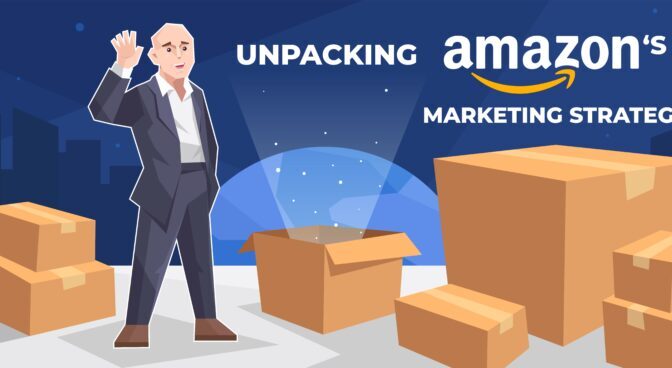
Unpacking Amazon's World-Dominating Marketing Strategy
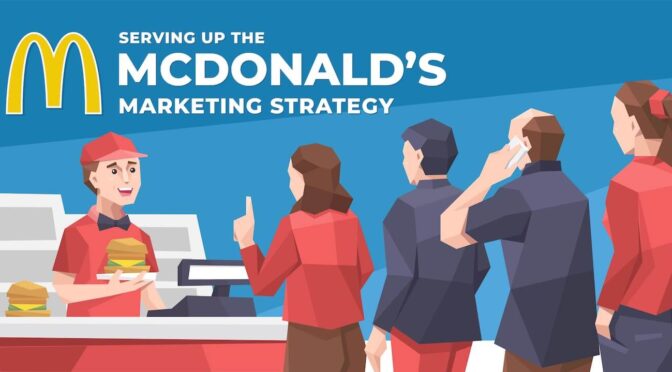
The (Epic) McDonald's Marketing Strategy: Serving Up Growth
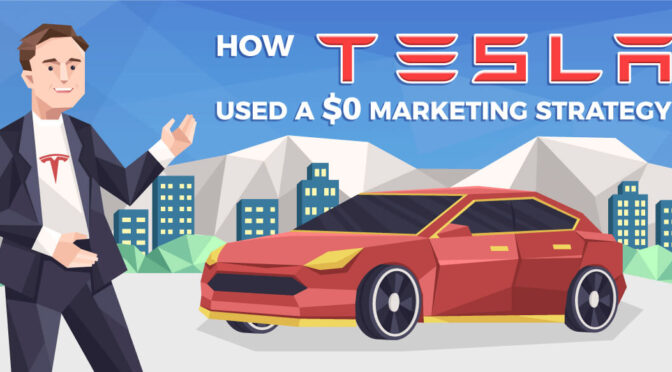
How Tesla Used a $0 Marketing Strategy To Dominate a Market
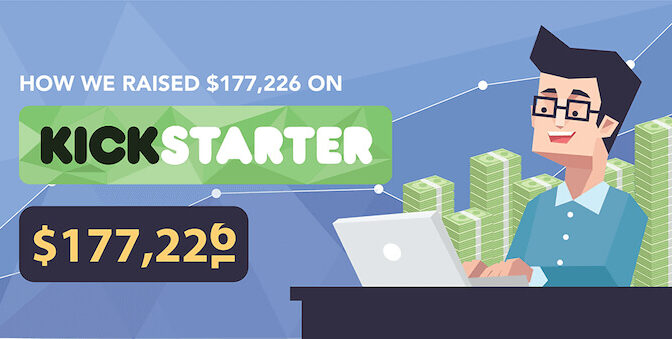
How We Raised $177,226 on Kickstarter – and Got in Men’s Health
2 leave a reply.
Having an effective logo can benefit your company. A logo gives your company an easily recognized visual symbol.
[…] Resource: Starbucks Marketing Resource […]
popular post

Get the Guide
You'll learn how to:
- Generate more demand for your product or service
- What channels to start with at first
- Strategies to maximize your lead generation
- And so much more!

Houston, we have a problem... you need to login first!
Register For This Site
A password will be e-mailed to you.
Get In-Depth Marketing Strategies
Sign up to get in-depth marketing strategies, tactics, and case studies delivered right to your inbox.
100% privacy. We will never spam you!
Copyright @ MarketingStrategy.com 2024. All Right Reserved.

- About / Contact
- Privacy Policy
- Alphabetical List of Companies
- Business Analysis Topics
Starbucks’ Marketing Mix: 4P Analysis
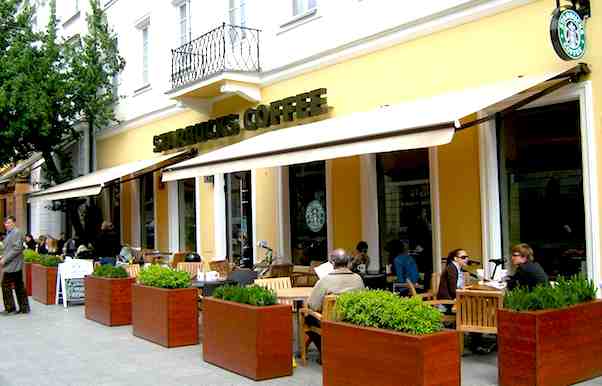
Starbucks Corporation’s marketing mix (4Ps) supports the firm’s industry position as the leading coffeehouse chain in the world. The marketing mix identifies the main components of the coffee company’s marketing plan, namely, product, place, promotion, and price (the four Ps). In this business analysis case, Starbucks uses its 4P to develop its brand image and ensure profitability. With the strongest brand in the coffeehouse industry, the company shows how an effective marketing mix and marketing strategy can support brand development and multinational business growth. Starbucks occasionally changes its 4P to respond to strategic challenges in the market, including competitive forces involving other coffeehouse firms, like Tim Hortons, as well as foodservice companies, like Dunkin’, McDonald’s , Burger King , Wendy’s , and Subway . These competitors challenge the company’s market position, as explained in the Five Forces analysis of Starbucks . The coffee company’s marketing mix functions as a strategic approach to counteract competition.
The marketing mix or 4P is a strategic tool for a unified and systematic approach to bringing Starbucks’ products to food and beverage markets around the world. Based on its 4Ps, the coffeehouse company applies a combination of marketing strategies and tactics to promote the right products at the right places at the right prices. The success of the marketing mix contributes to operational effectiveness and supports Starbucks’ mission statement and vision statement .
This component of the marketing mix focuses on what the coffee business offers to customers. Starbucks Corporation innovates its product mix (and its 4Ps) to capture more of the market. The company modifies food and beverage product lines with the aim of expanding its market reach and growing its market share. The following are the main categories in Starbucks’ product mix:
- At Home Coffee (instant and home-brew coffee)
- Merchandise (cups, tumblers, mugs, etc.)
Starbucks’ product mix is a result of years of business innovation and strategic changes in the marketing mix. For example, the company added the Frappuccino line after acquiring The Coffee Connection in 1994. Today, the business continues its product innovation to offer new foods and beverages that attract and keep more customers. The resulting marketing mix, together with Starbucks’ generic strategy for competitive advantage and intensive strategies for growth , ensures that products match consumer preferences in a diverse international market. Thus, this part of the 4Ps involves beverages, foods, and merchandise that are carefully selected or designed to satisfy the needs and preferences of target consumers worldwide.
Place in Starbucks’ Marketing Mix
This marketing mix component determines the venues where customers access the company’s foods, beverages, and merchandise. Starbucks offers most of its products at cafés or coffeehouses. However, other places or channels of distribution are included in this 4P component. This marketing case shows that Starbucks Corporation distributes its products through the following venues or places to reach target consumers:
- Coffeehouses/Cafés
- Website and mobile apps
Coffeehouses or cafés are the most noticeable distribution venues in Starbucks’ marketing mix. These places are strategically located in areas that have high pedestrian traffic, such as malls and commercial centers. Starbucks’ organizational structure (company structure) facilitates the management of franchising and licensing operations for these store locations. Retailers are also included in the coffeehouse company’s 4Ps, as channels for maximizing distribution and market reach. These places enable the company to distribute coffee products, such as VIA instant coffee and other merchandise. In addition, online venues are in Starbucks’ marketing mix. The company’s website and mobile apps provide easy access for customers who want to check available products or place their orders for pickup or for delivery through third-party service providers. The information technology used in this 4P component addresses the sociocultural and technological trends described in the PESTEL/PESTLE analysis of Starbucks . Thus, the company’s marketing mix involves strategies and tactics that use different types of locations to optimize the distribution of food and beverage products. The high visibility and accessibility of these places contribute to a positive brand image, which is one of the strengths assessed in the SWOT analysis of Starbucks .
Starbucks’ Promotion
In the marketing mix, promotions, also known as the marketing communications mix, refer to communication strategies and tactics for the goal of improving Starbucks’ brand, revenues, and market share. For example, the promotional mix can focus on persuading consumers to buy the company’s tea and instant coffee products. Starbucks’ marketing mix includes the following promotional activities:
- Word-of-mouth marketing
- Advertising
- Sales promotions
- Public relations
Word-of-mouth marketing is the most significant promotional strategy in Starbucks’ marketing mix. The company focuses on high-quality customer experience to encourage people to spread positive reviews that promote the coffeehouse business. Starting with Howard Schultz’s leadership, the emphasis on high quality through Starbucks’ company culture (work culture) helps create such good experiences for customers. In addition, advertising is an integral part of the coffee company’s 4Ps. For example, the company’s coffee and tea ads reach target customers through the Internet and print media. Moreover, the marketing mix involves sales promotions as a communications strategy to persuade consumers to buy more of the company’s foods and beverages. For example, the Starbucks Rewards program provides freebies for customers. In this approach, consumers buy more of the company’s products while expecting freebies, such as free coffee. Furthermore, the company uses public relations to promote its brand and coffee products. In the 4P context, the Starbucks Foundation functions as a part of a public relations strategy. The Foundation assists organizations and communities while promoting the coffeehouse company in the process. Starbucks’ stakeholder management and corporate social responsibility (CSR) and ESG strategy for sustainability and other goals relate to public relations in this marketing mix.
Prices & Pricing Strategy in Starbucks’ 4Ps
Starbucks uses a premium pricing strategy . This strategy involves relatively high price points and price ranges for products that the coffeehouse business presents as superior-quality or high-end (“premium prices” for “premium products”). In the marketing mix context, Starbucks’ pricing strategy takes advantage of the behavioral tendency of consumers to purchase expensive products based on the perception that high prices mean high quality, high value, and high status. This part of the 4P also helps strengthen the premium brand against competitors, like McDonald’s McCafé Premium Roast. Starbucks’ operations management optimizes quality and costs to support the pricing strategy in this marketing mix.
- Reddy, T. N., Ghouse, S. M., & JS, R. K. (2023). Marketing Mix – Review of P. Research Journal of Humanities and Social Sciences, 14 (1), 55-58.
- Solberg, C. A., & Durrieu, F. (2023). Patterns of international marketing strategy. Journal of Business & Industrial Marketing, 38 (7), 1532-1544.
- Starbucks Coffee Company Menu .
- Starbucks Corporation – Form 10-K .
- Starbucks Delivers .
- Starbucks Rewards .
- The Starbucks Foundation .
- U.S. Department of Agriculture – Economic Research Service – Food Service Industry Market Segments .
- Copyright by Panmore Institute - All rights reserved.
- This article may not be reproduced, distributed, or mirrored without written permission from Panmore Institute and its author/s.
- Educators, Researchers, and Students: You are permitted to quote or paraphrase parts of this article (not the entire article) for educational or research purposes, as long as the article is properly cited and referenced together with its URL/link.

Case Study Of Starbucks: How Starbucks Became The Coffee King?
Supti Nandi
February 21, 2024
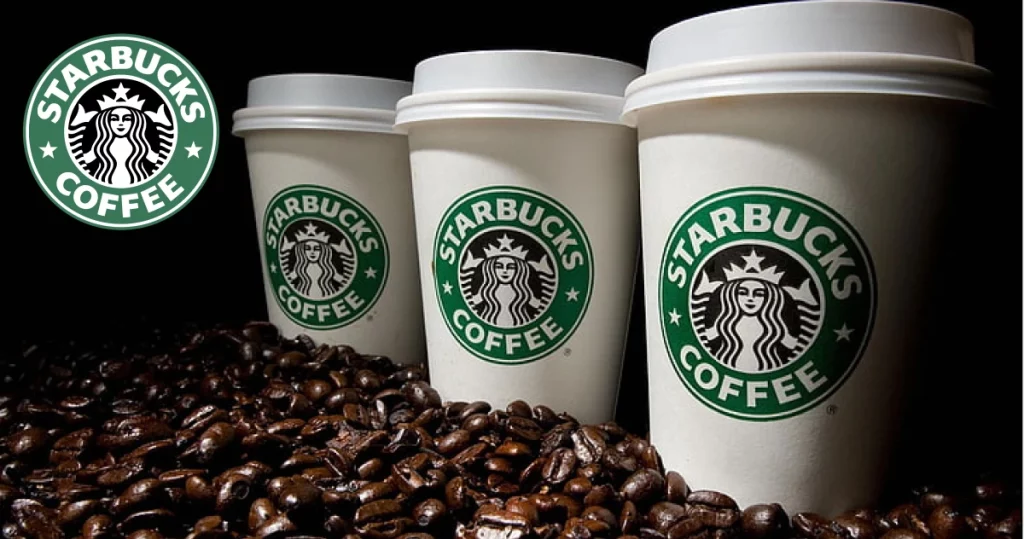
Starbucks, a brand that became synonymous with coffee has created a sensation in the world with its coffeehouse culture. Have you wondered how? Well, to answer this question we will delve into the case study of Starbucks.
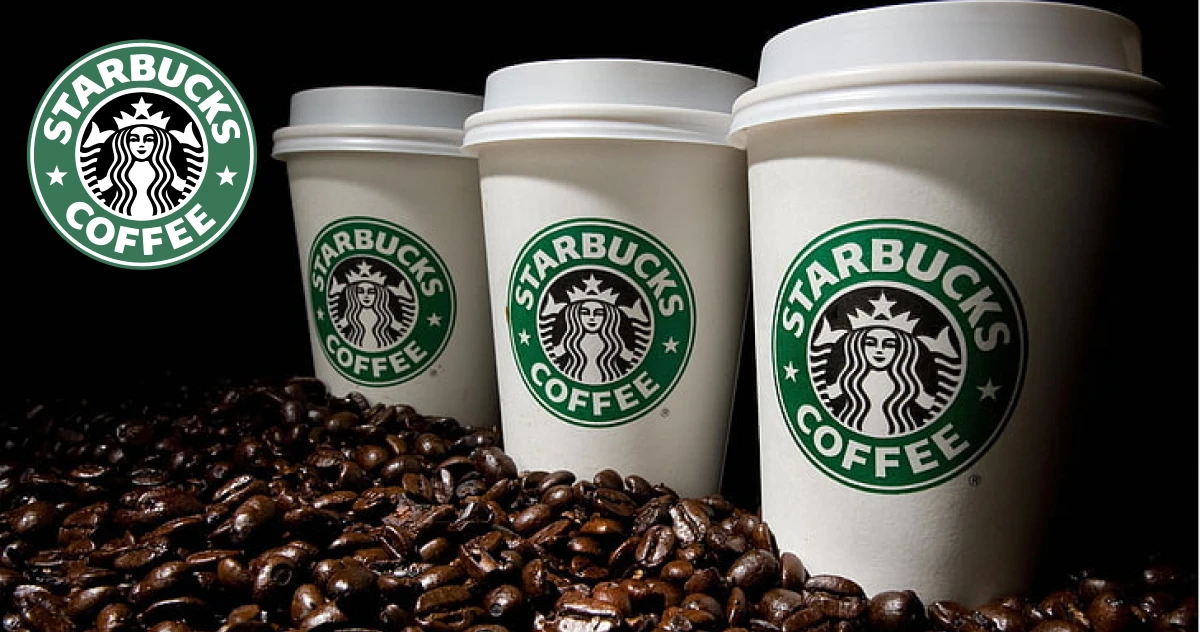
Stay tuned!

(A) Starbucks: A Brief Overview
Let’s buckle up for a Starbucks journey! Founded back in 1971, this coffee giant now reigns supreme as the world’s largest coffeehouse chain, with its home base in the city of Seattle, Washington.
Before diving deeper into the Starbucks case study, let’s have a look at the company’s profile-
Fast forward to November 2022, and you’ve got Starbucks waving its coffee wand in a staggering 35,711 stores across 80 countries. And when you zoom in on the U.S., you’re looking at a whopping 15,873 Starbucks hotspots.
Here’s the scoop – over 8,900 are Starbucks-run, and the rest are running under licensed partnerships.
Now, let’s talk coffee vibes. Starbucks is the unsung hero of the second wave of coffee culture, dishing out an array of coffee delights. Think hot espresso, chill Frappuccinos, and a lineup of pastries and snacks that’s strong enough to trigger your taste buds.
Oh, and did you know some Starbucks treats are exclusive to certain locations? How? You may wonder. Well, here’s a bonus – most Starbucks joints worldwide offer free Wi-Fi. Coffee and connectivity – a match made in heaven.
So there you have it – the Starbucks saga!
(B) Business Overview of Starbucks Case Study
Understanding the business perspective is one of the essential parts of the Starbucks case study. Reason? You will get to know how Starbucks is performing in the market in terms of financials and business.
Go through the table given below-
In today’s date, the coffee giant is flexing a market capitalization of a whopping $105.82 billion – that’s some serious coffee beans.
Now, rewind to 2023, and Starbucks made it rain with a revenue of $35.976 billion. But what about the nitty-gritty? Operating income in 2022 hit $4.62 billion, while net income settled at $3.28 billion. These aren’t just numbers; they’re the financial pillars of Starbucks.
That’s not all!
Hold onto your coffee cups; we’re diving into assets and equity. Total assets in 2022 clocked in at $27.98 billion – that’s like a treasure chest of coffee goodness. But here’s a twist – total equity dipped to -$8.70 billion. It’s like a plot twist in a coffee-fueled drama.
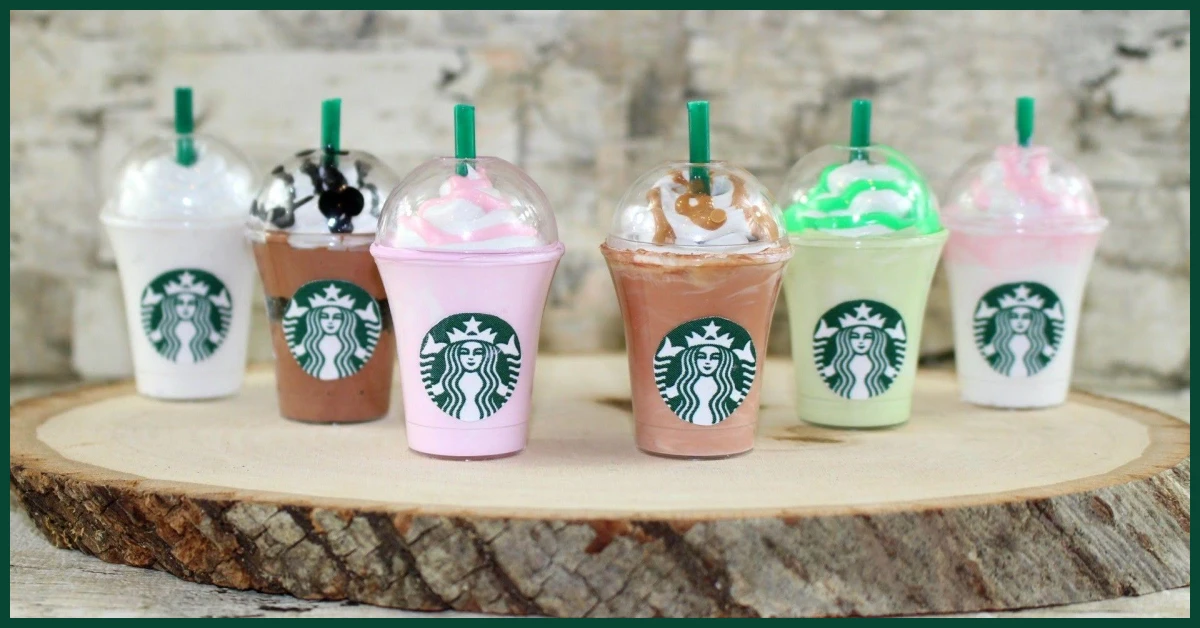
Now, let’s talk about expenses and profits. In 2023, expenses tallied up to $30.584 billion, but here’s the kicker – profits soared to $25.108 billion.
That’s like balancing a delicate espresso shot with a mountain of whipped cream.
In a nutshell, Starbucks isn’t just brewing coffee; it’s a financial powerhouse, stirring up a caffeinated storm in the business world.
(C) History of Starbucks: Timeline & Key Events
Coming to the third part of the Starbucks case study, let’s delve into the history of Starbucks-
Founded in 1971 by Jerry Baldwin, Zev Siegl, and Gordon Bowker at Seattle’s Pike Place Market, Starbucks underwent pivotal changes in ownership and leadership. In the early 1980s, Howard Schultz acquired the company and transformed it into a coffee shop, introducing espresso-based drinks after being inspired during a business trip to Milan, Italy.
Schultz served as CEO from 1986 to 2000, orchestrating an expansive franchise expansion across the West Coast.
Orin Smith succeeded Schultz, focusing on fair trade coffee and boosting sales to US$5 billion. Jim Donald took the helm from 2005 to 2008, overseeing substantial earnings expansion. Schultz returned during the 2007–08 financial crisis, steering the company towards growth, expanded offerings, and a commitment to corporate social responsibility. Kevin Johnson assumed the CEO role in 2017.
In March 2022, Starbucks announced Schultz’s return as interim CEO in April 2022, with Laxman Narasimhan appointed to succeed him in April 2023. Narasimhan assumed the position earlier, in March 2023.
Beyond beverages and food, Starbucks stores offer official merchandise and select locations to provide “Starbucks Evenings” with beer, wine, and appetizers. The company’s products, including coffee, ice cream, and bottled drinks, are available in grocery stores globally. The Starbucks Reserve program, initiated in 2010 for single-origin coffees and high-end shops, has evolved. Starbucks operates six roasteries with tasting rooms and 43 coffee bars.
The company faced controversies but maintains substantial brand loyalty, market share, and value. As of 2022, Starbucks ranks 120th on the Fortune 500 and 303rd on the Forbes Global 2000.
(D) Significance of Logo in Starbucks Case Study
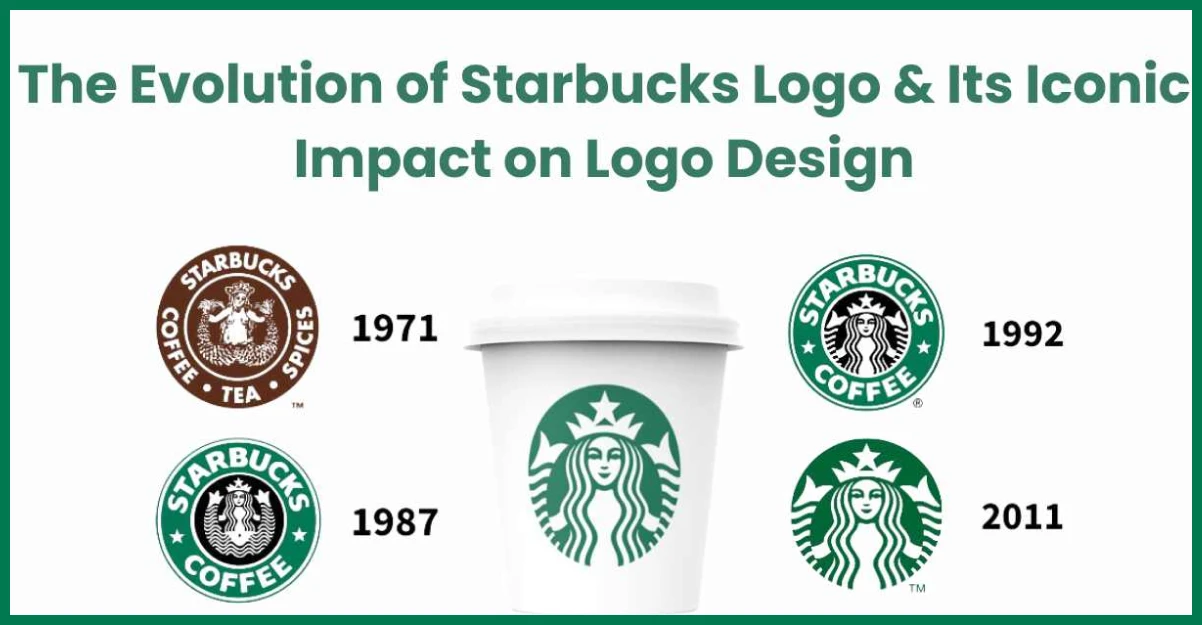
Let’s delve into the details of the Starbucks logo evolution. In its inception in 1971, the original Starbucks logo featured a complex design comprising a two-tailed mermaid or siren, encompassed by a wordmark. This design was a visual nod to the brand’s early identity and origins. The mermaid, with its twin tails, was a dual representation of the sea and Seattle, the birthplace of Starbucks.
As the brand progressed, the logo underwent a significant transformation. The evolution saw a shift towards simplicity, as the wordmark surrounding the mermaid was phased out. This marked the beginning of the modern Starbucks logo we recognize today.
The current emblem showcases a simplified and stylized green siren enclosed within a matching green ring, emphasizing a cleaner and more focused visual identity.
Beyond aesthetics, the modern logo carries symbolic weight. The green mermaid within the circle has become an iconic representation of Starbucks’ commitment to delivering high-quality coffee experiences.
Additionally, it reflects the brand’s emphasis on creating a sense of community that extends beyond geographical boundaries.
In essence, the evolution of the Starbucks logo is a journey from a detailed and intricate design to a streamlined and symbolic representation. It mirrors the brand’s growth, emphasizing its roots, dedication to quality, and the broader cultural impact it seeks to make through coffee and community.
(E) Market Penetration Strategy: How Starbucks became the coffee king?
In this section, we will look into the key plans and actions that helped Starbucks gain a strong foothold in the beverage and cafe industry.
Starbucks continues to blend innovation and growth, navigating the ever-changing landscape of the coffee industry.
(F) Starbucks Entry in India: Core of Starbucks Case Study
In 2012, Starbucks initiated its venture into India through a significant 50:50 joint venture with Tata Consumer Products Ltd. The inaugural flagship store, which opened its doors on October 19th, 2012, found its home in the historic Elphinstone Building in Mumbai.
The architectural design of this store ingeniously merged Starbucks’ global coffee legacy with the vibrant local culture, creating a welcoming space for community and connection. Over time, this Mumbai location evolved into India’s first Starbucks Reserve® Store, setting the stage for an elevated coffee experience.
(F.1) The Starbucks Reserve® Store Unveiled: A Coffee Lover’s Haven
The introduction of the Starbucks Reserve® Store marked a milestone in the coffee giant’s presence in India. Spanning an impressive 5,200 square feet, this store greeted customers with the intoxicating aroma of coffee.
The entrance featured a stunning monolithic terrazzo Reserve bar, a masterpiece crafted by local artisans. Trained black apron coffee masters curated an exceptional coffee experience, showcasing rare and exquisite brews through various brewing methods.
This Reserve Store was not just a coffee shop; it was a canvas for creating unique moments of connection through the artistry of coffee.
(F.2) Expanding Horizons: Tata Starbucks’ Nationwide Presence
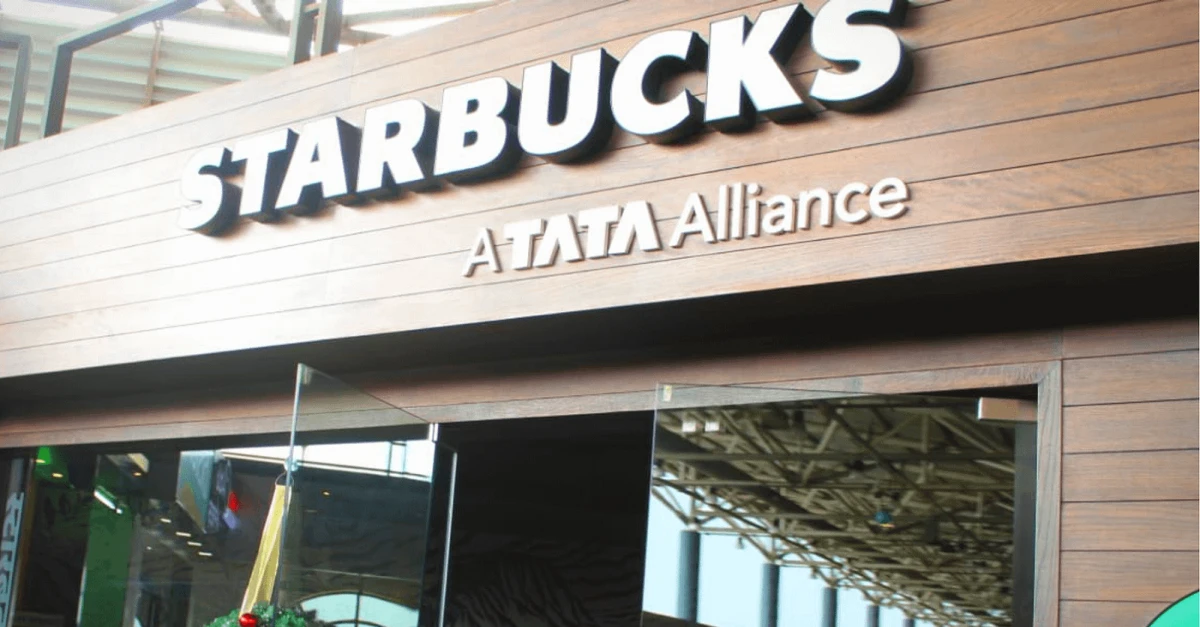
Tata Starbucks established a substantial footprint, operating 350+ stores spread across 36 cities in India. In a significant achievement in 2022, Starbucks executed its largest single-year expansion in India, reaching 14 new cities. The brand’s influence spanned major cities such as Mumbai, Delhi NCR, Hyderabad, Chennai, Bengaluru, Pune, and more.
(F.3) Coffee Blends Celebrating Indian Flavors and Heritage
Starbucks paid homage to India’s rich coffee heritage by introducing special blends. The India Estates Blend, sourced from estates in Coorg and Chikmagalur, the birthplace of coffee in India, made its debut in 2013. Additionally, the Diwali Blend, introduced in 2020, served as a tribute to India’s vibrant culture and longstanding coffee traditions.
(F.4) The Tata Alliance: A Successful Partnership
Starbucks in India proudly bore the branding “Starbucks Coffee – A Tata Alliance,” underscoring the synergy between Starbucks and Tata Global Beverages.
Starbucks’ journey in India was not merely about coffee; it was about brewing connections, transcending cultural boundaries, and crafting unforgettable coffee experiences that resonated with the diverse tapestry of India.
(G) Business and Marketing Strategies of Starbucks in India
Starbucks, despite entering India’s coffee scene with strong strategies, faced challenges in a market dominated by competitors like Cafe Coffee Day and Barista Lavazza. Unlike the U.S., where coffee is a staple, India is traditionally a tea-drinking country.
Starbucks aimed to create a space for relaxation, blending its global coffee legacy with local culture.
Let’s look at the business and marketing strategies of Starbucks in India-
In short, Starbucks’ journey in India reflects a careful blend of global strategies and localized approaches, aiming to create a unique and sustainable presence in a market with diverse preferences and cultural nuances. The success indicators appear promising, showcasing Starbucks’ commitment to long-term growth and meaningful community integration.
Note: Do you know Starbucks collaborated with Apple during the horizontal marketing in the US? We have covered it thoroughly here- Horizontal Marketing System . You can check it out for detailed information.
(H) Wrapping Up the Case Study of Starbucks
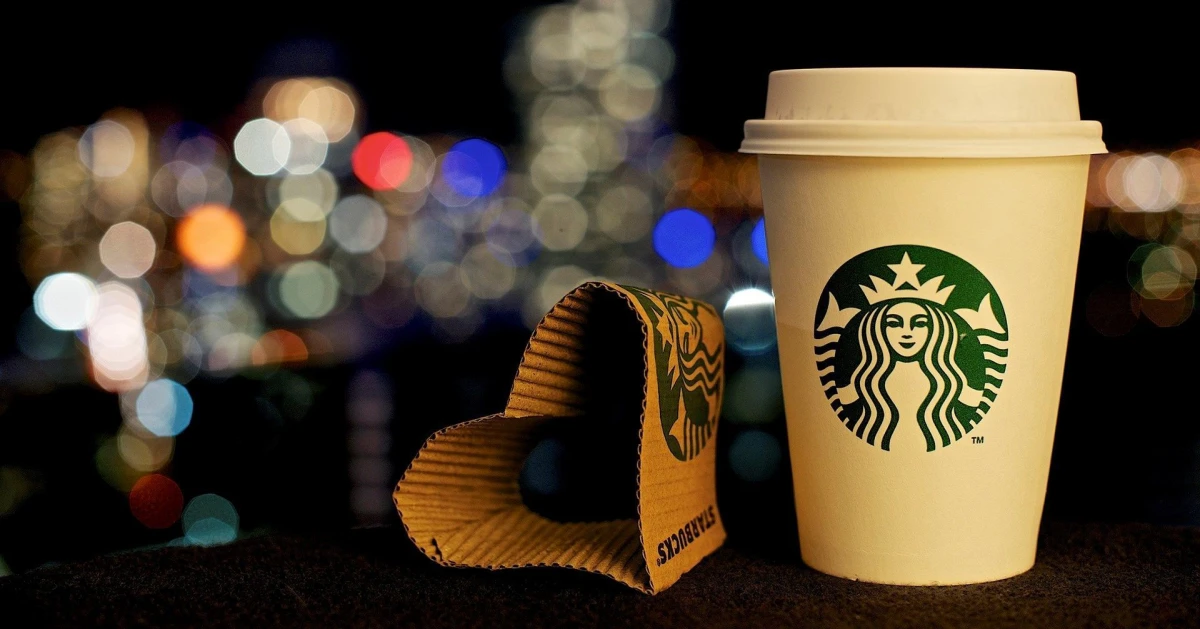
The Case Study of Starbucks unveils a fascinating journey that transformed Starbucks into the reigning coffee king. What started as a local coffee bean store in Seattle’s Pike Place Market in 1971 boomed into a global coffee empire. The strategic moves, like Howard Schultz’s visionary shift to espresso-based drinks, had set the stage for Starbucks’ aggressive expansion.
Throughout its evolution, Starbucks faced challenges, leadership changes, and controversies, but resilience and strategic pivots marked its trajectory. The decision to focus on corporate social responsibility under Schultz’s leadership during the financial crisis showcased Starbucks’ adaptability.
The engagement with local cultures, from the iconic two-tailed mermaid symbol to store designs reflecting regional aesthetics, contributed to Starbucks’ success. Key partnerships, like the one with TATA in India, demonstrated a keen understanding of local markets.
Starbucks’ commitment to quality, community, and sustainability resonated with consumers globally. From unique store experiences to tailored product launches, Starbucks consistently adapted its offerings to cater to diverse tastes.
In essence, the Case Study of Starbucks illuminates a narrative of coffee, community, and corporate strategy, culminating in Starbucks’ reign as the coffee king.
The journey is a testament to the power of adaptability, brand loyalty, and a steaming cup of coffee that transcends borders, making Starbucks an integral part of daily rituals worldwide!
Related Posts:
Contact Info: Axponent Media Pvt Ltd, 706-707 , 7th Floor Tower A , Iris Tech Park, Sector 48, Sohna Road, Gurugram, India, Pin - 122018
© The Business Rule 2024
Academia.edu no longer supports Internet Explorer.
To browse Academia.edu and the wider internet faster and more securely, please take a few seconds to upgrade your browser .
Enter the email address you signed up with and we'll email you a reset link.
- We're Hiring!
- Help Center

The Siren's Lure - A Starbucks Influencer Marketing Case Study

2020, Better Marketing [Medium]
This article explores how and why Starbucks engages online influencers to popularize their products. By looking at Starbucks’s corporate communications and the way they deal with journalists, we’ll get an idea of why and how influencer marketing works for the company. To conclude, we will go deeper into the meaning of media-texts about Starbucks. What is it that Starbucks is really selling? What’s the essence of what bloggers and vloggers are drawn to at Starbucks?
RELATED TOPICS
- We're Hiring!
- Help Center
- Find new research papers in:
- Health Sciences
- Earth Sciences
- Cognitive Science
- Mathematics
- Computer Science
- Academia ©2024

Starbucks Case Study - How Starbucks Conquered The Coffee Industry?

Devashish Shrivastava
Starbucks Corporation is an American coffee chain that was established in 1971 in Seattle, Washington. By mid-2019, the organization had a presence in over 30,000 areas around the world. Starbucks has been depicted as the fundamental delegate of "second wave espresso," a reflectively-named development that advanced high-quality espresso and specially simmered coffee. Starbucks now uses robotized coffee machines for proficiency and well-being.
Starbucks serves hot and cold beverages, entire bean espresso, micro-ground moment espresso known as VIA, coffee, caffe latte, full-and free leaf teas such as Teavana tea products, Evolution Fresh squeezes, Frappuccino refreshments, La Boulange baked goods, and bites (for example, chips and wafers); some offerings such as the Pumpkin Spice Latte are explicit to the territory of the store. Numerous Starbucks outlets sell pre-bundled nourishment items, sweltering and cold sandwiches, and drinkware such as cups and tumblers. Furthermore, there are Select "Starbucks Evenings" areas that offer brew, wine, and appetizers.
Starbucks first ended up productive in Seattle in the mid-1980s. Despite an underlying financial downturn with its venture into the Midwest and British Columbia in the late 1980s, the organization experienced rejuvenated success with its entrance into California in the mid-1990s. Starbucks opened an average of two new stores every day between 1987 and 2007. On December 1, 2016, Howard Schultz reported he would leave his position as the CEO and would be supplanted by Kevin Johnson. Johnson accepted the role of the CEO of Starbucks on April 3, 2017, and Howard Schultz resigned to end up as the 'Chairman Emeritus', effective from June 26, 2018. Kevin Johnson is currently serving as the CEO and President of Starbucks.
Starbucks - Company Highlights
Startup Story Of Starbucks Corporation History Of Starbucks Corporation Starbucks - Name and Logo Starbucks Expansion Journey Starbucks Corporation in India Business Strategy Of Starbucks In India Products Of Starbucks Corporation Business Growth Of Starbucks Corporation Over The Years Future Plans Of Starbucks Corporation
Startup Story Of Starbucks Corporation

If you are wondering how did Starbucks start? Then, the story of Starbucks started back in 1971, when the company was a roaster and retailer of whole bean and ground coffee, tea and spices with a single store in Seattle’s Pike Place Market.
Zev Siegel stated that at that time he knew the coffee industry inside and out, he was well-versed, especially with the gourmet end of the industry. Besides, he was also known as the most educated coffee guy in the country at that time. So, the three college friends - Zev Siegel, Jerry Baldwin and Gordon, started out with their coffee bean shop and roastery at Seattle’s famous Pike Place Market in 1971. Eventually, they found a mentor in Alfred Peet, who was the founder of Peet’s Coffee and the man responsible for bringing custom coffee roasting to the U.S. and started with the coffee business in full swing. Starbucks initially began by selling coffee beans that were roasted by Peet's, a gourmet coffee company in Berkeley, California, and later on, started roasting on their own.
History Of Starbucks Corporation
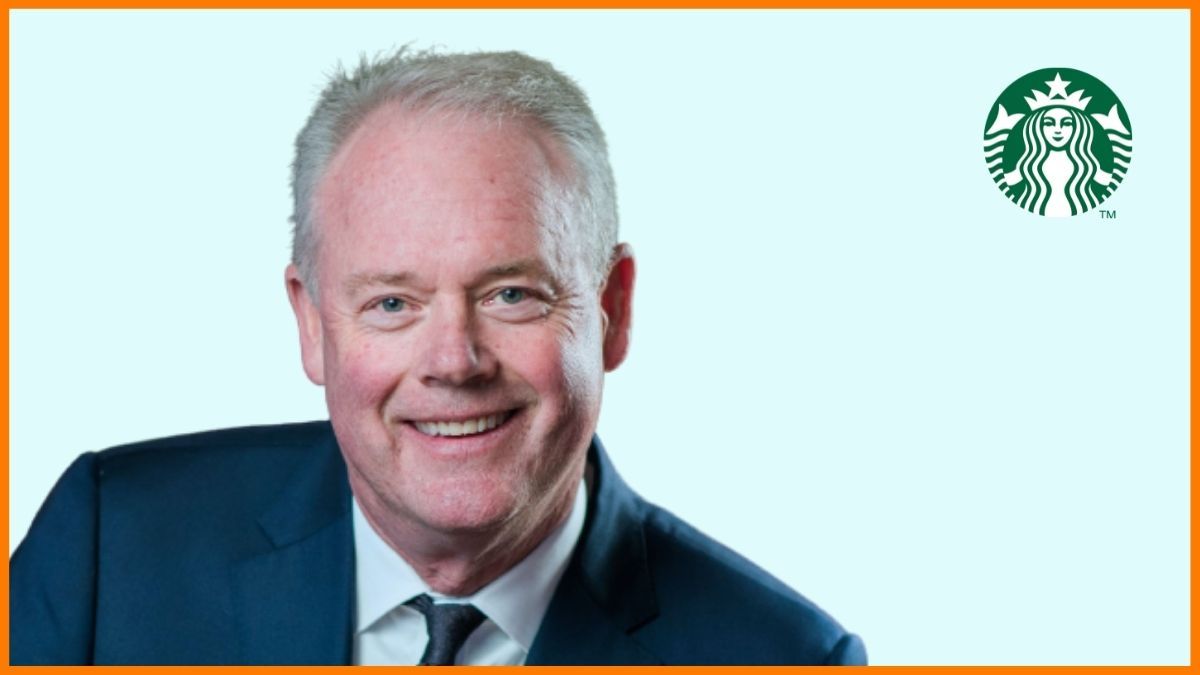
The first Starbucks store was initiated in 1971 in Washington by 3 individuals who met while they were studying at the University of San Francisco: English educator Hun Baldwin, history educator Zev Siegl, and author Gordon Bowker. The trio was encouraged to sell top-notch espresso beans and hardware after businessman Alfred Peet showed them his style of simmering beans.
During this time, the organization sold simmered, entire espresso beans. During its first year of activity, Starbucks bought green espresso beans from Peet's, and then started purchasing legitimately from producers.
Starbucks - Name and Logo

Bowker reviews that Terry Heckler, with whom Bowker claimed a publicizing office, thought words starting with "st" were ground-breaking. The organizers conceptualized a rundown of words starting with "st" and in the long run arrived on "Strabo," a mining town in the Cascade Range. The team then finalized on "Starbuck," the name of the young chief mate in the book "Moby-Dick".
Starbucks has given too many slogans/taglines already among which the most popular one is - " Brewed for those who love coffee".
Starbucks Expansion Journey

In 1984, the first proprietors of Starbucks, driven by Jerry Baldwin, acquired Peet's. During the 1980s, all-out offers of espresso in the US were falling. However, offers of strength espresso expanded, shaping 10% of the market in 1989; it stood at just 3% in terms of market share in 1983. By 1986, the organization worked six stores in Seattle and had just barely started to sell coffee.
In 1987, the first proprietors sold the Starbucks chain to the previous manager Howard Schultz, who rebranded his II Giornale espresso outlets as Starbucks and immediately extended. Starbucks then launched its outlets outside Seattle at Waterfront Station in Vancouver, British Columbia, and Chicago, Illinois. By 1989, 46 stores existed over the Northwest and Midwest, and every year Starbucks was simmering more than 2,000,000 pounds (907,185 kg) of coffee. At the hour of its first sale of stock (IPO) on the financial exchange in June 1992, Starbucks had 140 outlets with an income of $73.5 million, up from $1.3 million in 1987.
The organization's fairly estimated worth was $271 million at this point. The 12% segment of the organization that was sold raised around $25 million for the organization, which encouraged a multiplying of the number of stores throughout the following two years. By September 1992, Starbucks' offer cost had ascended by 70% to more than multiple times the income per portion of the past year. In July 2013, over 10% of in-store buys were made on the client's cell phones utilizing the Starbucks app.
The organization used the versatile social media stage when it propelled the "Tweet-a-Coffee" campaign in October 2013. People had the option to buy a $5 gift voucher for a companion by entering both "@tweetacoffee" and the companion's handle in a tweet. Research firm Keyhole observed the advancement of the event and a media article from December 2013 detailed that Starbucks had discovered that 27,000 individuals had taken an interest and $180,000 of buys were made to date.

As of 2018, Starbucks is positioned 132nd on the Fortune 500 rundown of the biggest United States organizations by revenue. In July 2019, Starbucks announced a "monetary second from last quarter total compensation of $1.37 billion, or $1.12 per share, up from $852.5 million, or 61 pennies for each offer, a year sooner." The organization's fairly estimated worth of $110.2 billion expanded by 41% in the middle of 2019. The income per share in quarter three was recorded at 78 pennies, considerably more than the estimate of 72 cents.
Starbucks Corporation in India

In January 2011, Starbucks Corporation and Tata Coffee reported designs to start opening Starbucks outlets in India. Despite a bogus beginning in 2007, in January 2012, Starbucks declared a 50:50 joint endeavour with Tata Global Beverages, called Tata Starbucks Ltd. , which would possess and work outlets marked "Starbucks, A Tata Alliance". Starbucks had endeavoured to enter the Indian market in 2007. However, it didn't provide any explanation behind its withdrawal of it.
It was on October 19, 2012 that Starbucks opened its first store, a 4,500 sq ft store in Elphinstone Building, Horniman Circle, Mumbai. Starbucks opened its first cooking and bundling plant in Coorg, Karnataka in 2013 to supply its Indian outlets. The company extended its reach to Delhi on 24 January 2013 by opening 2 outlets. Tata Global Beverages declared in 2013 that they would have 50 areas before the end of the year, with a venture of ₹4 billion ($58 million). The organization did open its 50th store in India on July 8, 2014.
The third city of India to get a Starbucks outlet was Pune, where the organization opened an outlet at Koregaon Park on 8 September 2013. Starbucks opened a 3,000-square-foot lead store at Koramangala, Bangalore on 22 November 2013, making it the fourth city to have an outlet. Starbucks opened the biggest espresso-forward store in the nation at Vittal Mallya Road, Bangalore on 18 March 2019. The store is estimated at 3,000 sq ft and is Starbucks' 140th outlet in India.
Tata Starbucks opened 25 stores between 2017 and 2018, which went up to 30 during 2018-19. On 21 February 2019, CEO Navin Gurnaney reported that Tata Starbucks would use only compostable and recyclable bundling materials over the entirety of its stores from June 2020.

Starbucks reported its entrance in Gujarat on 7 August 2019. The organization opened five stores in Surat and Ahmedabad the following day. Starbucks' leader store in the state is situated at Prahlad Nagar, Ahmedabad, and offers more vegan alternatives than other Indian outlets. CEO Navin Gurnaney expressed that the organization would open more than 30 stores in the 2019-20 financial year, of which 11 have already been opened.
Business Strategy Of Starbucks In India
Starbucks' strategies for business in India seemed rock-solid but the brand wasn't completely immune still. In any case, the world's biggest bistro chain is building its position cautiously via a progression of well-picked steps. Numerous worldwide brands have entered India since the 1990s, being pulled in by its developing and optimistic customer base. Yet, not all have succeeded.
Starbucks isn't the primary contestant in India's composed espresso showcase; so it doesn't have any first-participant advantage. Cafe Coffee Day (CCD) is the market head while Barista Lavazza was the main espresso chain to open for business. Both are valued by the white-collar class. Costa Coffee, Coffee Bean and Tea Leaf (CBTL), and Gloria Jean are valued by the rich group in India.
India is customarily a tea-drinking nation, so espresso chains have concentrated on giving a feel where individuals can unwind and invest energy with one another. This setup implies higher capital expenses. It is different from the US, where the vast majority have a liking for espresso. The Indian buyer base has likewise advanced in the recent decade. What can worldwide brands like Starbucks do to augment their odds of achievement in India? Here are a few thoughts:
Picking a Local Partner
Worldwide brands face the difficult choice of either going solo or tying up with a nearby accomplice. Starbucks' choice to team up with India's TATA Global Beverages demonstrates attention to utilizing different advantages. The TATA Group is one of India's morally determined brands, an observation passed on about Starbucks India too.
Given that India produces espresso beans in just a couple of spots, the other sourcing alternative was bringing in the beans. Be that as it may, this would have raised costs fundamentally.
Tata's espresso plant in Karnataka has been contracted to supply beans to Starbucks' universally, making common cooperative energies. It has contracted to take into account TATA's TAJ SATS, which supplies to TATA's top-notch lodging network – The TAJ. The TATAs are put into the retail part with store brands like Westside, Tanishq, Croma, Star Bazaar, and so forth. Starbucks can use them for information sharing on Indian land, territory points of interest, and handling land administrations. This would enable its very own development to outline. This strategy gives scope for store-in-store deals.
Consistency in Store Arrangements
This keeps up the one-of-a-kind selling purpose of customer experience and allows to pick up economies of scale on CAPEX. Starbucks plans to have a similar store group crosswise over India. However, the size can change depending on financial matters. This is how it works all around. Starbucks wants to provide an agreeable 'café' experience. Having a similar organization gives clients the solace of accepting the equivalent 'Starbucks' vibe any place they go throughout the world.
Keeping the store designs steady means it needs to pick and open new areas stringently, to such an extent that the area can yield a throughput by the venture. Its methodology in-store arrangement is different from CCD, which has picked various configurations to tap the potential interest in any region. CCD has opened a couple of premium outlets dependent on the area's customer profile . It has additionally gone for non-store organizations like takeaway booths and candy machines. Be that as it may, Starbucks may expect that such non-store configurations may weaken its image esteem.
Estimating the Pace of Expansion
India is the place where an inability to screen primary concerns has tossed numerous organizations out of the rigging. So, a top-line just approach doesn't work here. Since Starbucks needs to pick new areas stringently by its equivalent configuration approach, it has decided on a deliberate pace of extension. It is concentrating on the budgetary feasibility of every outlet, as opposed to going for an aggressive development plan which may have brought about rehashed calls for capital.
This operational process is different from its system in the USA and China where it has fabricated scale by opening stores in pretty much every area – being the main port-of-call for espresso by basically being all over the place. CCD's methodology behind adaptable store organizations was to guarantee there is a CCD bistro at a simple reach. It is intriguing to check its normal store gainfulness given its scale.
Guaranteeing Top-Authority Backing and Responsibility
Top initiative responsibility from the two sides of the organization, Tata and Starbucks, has been plentifully clear. Starbucks took as much time as is needed to enter the market (6 years), recognizing that India was a mind-boggling market and required cautious passage arranging. The two sides have spoken finally about their dedication and shared their future plans to give their business a new direction toward growth.
Altering Contributions to Suit Indian Market and Client Needs
Being adjusted to Indian culture, tastes, and inclinations conveyed at a suitable "esteem" guarantees customer importance, construct, and continued utilization. Starbucks mirrors this comprehension – as observed through a blend of western staples, a wide scope of intriguing Indian tidbits similar to confined refreshments on the idea. Since its experience ( and item as well, however to a lesser degree) is its image guarantee, its test lies in conveying an all-around steady, yet locally significant brand experience.
The stores, or the "third spot" as Starbucks calls them, have been altered likewise. The stores don't pursue the worldwide layout and appear to have been planned with consideration, with neighbourhood contacts consolidated. Stores in various urban communities have been structured unexpectedly, mirroring the neighbourhood culture – for e.g., New Delhi's store has ropes and chat on the dividers and henna designs on the floor, though the Pune store has a rich showcase of collectables and copper.
There appears to be sufficient utilization of shading – something missing in the US. The stores have been intended to convey a particular, premium café experience, predictable, and in a state of harmony with the one conveyed over the rest of the world.

Making Inventive and Restricted Plan of Action
Starbucks appears to have made a confined plan of action, planned for conveying a universally reliable item and involvement with locally-focused costs. The Tata group conveys a major sourcing advantage (attributable to its quality over the generation chain, developing, broiling, and exchanging espresso), yet it has just gone past that to develop and support associations with nearby espresso cultivators – putting resources into structure economical cultivating rehearses. All of Starbucks' espresso is sourced locally, a first-ever for the organization.
Scaling up using Arrangements and Organizations
The Tata organization is the genuine overthrow in the Starbucks passage story. Having Tata as an accomplice is gigantically profitable, not due to the validity and strength it offers, or because it coordinates the scale and stature of Starbucks as an organization.
It offers numerous advantages catalyzing pretty much every market section achievement variable - for example, The Tata group has involvement in the retail business , a solid reputation in advancing new pursuits, gives a sourcing advantage through Tata espresso, offers access to high traffic areas using its lodgings and other retail outlets, guarantee excellent nourishment and refreshment supply through its F&B business and so forth.
Furthermore, the potential for an effective organization is amazingly high given Starbucks' and Tata's mutual qualities – the two of them have a solid social inner voice and are resolved to "give back" to the general public and network.
Influencing India for Worldwide Items
Not long after it finished its first year, Starbucks reported that it was serving top-quality Indian Arabica espresso as "Indian coffee" in different markets. Another world-class office for cooking and bundling has just been initiated in Coorg, Karnataka; the results of which are to be analyzed in India and abroad.
Overseeing Discernment and Guidelines
This viewpoint is tied in with structure, a solid positive observation and a picture for the business and brand crosswise over key outer partners and crowds – incorporating the administration, corporate accomplices, networks inside the eco-framework, and customers on the loose. Given what Starbucks has figured out how to accomplish in a year and a half since dispatch, it appears to be genuinely evident that its thought combined with the Tata advantage (critical reach and impact) has helped in developing solid connections and a positive picture with key outside partners and voting demographics.
Engage Nearby Association
Starbucks is by all accounts constructing a nation-explicit activity with nearby individuals in charge and overall unmistakable customer interface focuses, giving them the necessary position to coordinate and work. There is overwhelming interest in enlisting the perfect individuals and giving the essential preparation – to install and instil the organization's culture and administration models.
Along these lines, how has Starbucks fared against the McKinsey spread out variables for long-haul India achievement? Its accomplishments against the scorecard look noteworthy. With thorough vigorous passage arranging and brilliant and quick execution, the multi-month-old endeavour appears to have impressive force, making purchaser and network-driven ventures and focused on sustaining its centre business and brand. It appears to be very much set to "win" in India.
Whether Starbucks will collect a huge piece of the overall industry and accomplish its objective of India being among its best 5 markets over the long haul is not yet clear. It's still early days, yet for the organization, this appears to be an incredible beginning and a great globalization model for multinationals looking for an India section.
Products Of Starbucks Corporation
Aside from the typical items offered globally, Starbucks in India has some Indian-style item contributions, for example, Tandoori Paneer Roll, Chocolate Rossomalai Mousse, Malai Chom Tiramisu, Elaichi Mewa Croissant, Chicken Kathi Roll, and Murg Tikka Panini to suit Indian customers. All coffees sold in Indian outlets are produced using Indian broiled espressos by Tata Coffee. Starbucks additionally sells Himalayan packaged mineral water. Free Wi-Fi is accessible at all Starbucks stores.

In January 2017, Tata Starbucks presented Starbucks' tea image "Teavana". Teavana offers 18 unique assortments of tea in India. One of the assortments called the India Spice Majesty Blend was explicitly created for the Indian market and is just accessible in India. India Spice Majesty Blend is a mix of full leaf Assam dark tea injected with entire cinnamon, cardamom, cloves, pepper, star anise, and ginger. On 15 June 2015, Tata Starbucks reported that it was suspending the utilization of fixings that had not been affirmed by the Food Safety and Standards Authority of India (FSSAI).
The organization didn't indicate what the fixings were or which items they were utilized in. The organization additionally expressed that it was applying for FSSAI endorsement for these ingredients.

As per the Latte Index positioning of the expense of a tall hot latte at Starbucks in 44 nations, India was the fifth most costly nation to buy the drink dependent on January 2016 costs. The record distributed by US-based buyer research firm ValuePenguin found that a tall hot latte cost $7.99 in India, far higher than the $2.75 it costs in the least expensive nation, the United States, yet much lower than the $12.32 in the most costly nation, Russia .
Tata Starbucks propelled the Starbucks Delivers program in mid-2019. The administration offers home conveyance from Starbucks outlets through an organization with Swiggy. The administration was first propelled in Mumbai, with designs to turn it out to other cities.
In its menu, the Tata Starbucks company has launched ice-creams as their new products. The frozen delights are available even in flavours like java chip and caramel macchiato among others and will come in takeaway tubs and single scoops. The ice-creams are now available in 50-60% of the Starbucks stores.
Business Growth Of Starbucks Corporation Over The Years

Tata Starbucks, a 50:50 joint endeavour between Tata Global Beverages and Starbucks Coffee of the US, has announced a 30% top-line development in financial 2018-19, driven by new store openings and improved execution. Tata Starbucks, which is hoping to make back the initial investment in the current money, has opened 146 stores to date. Tata Starbucks announced "twofold digit top-line development - 30% for the entire year, driven by new stores and improved store execution," Tata Global Beverages Ltd (TGBL) said in a financial specialists' introduction. Tata Starbuck's income for 2018-19 is required to be approximately INR 450 crores.
TGBL said Tata Starbucks opened 30 outlets in the past financial year, out of which 15 new stores were opened during the last quarter of the money-related year. The organization claimed detailed benefits at the store level; all urban areas were likewise productive, and additionally saw an ascend in nourishment share in general deals.
The Starbucks company has added around 40 stores in FY21 but the company had recorded a 33% Y-O-Y fall in its revenues during the same fiscal. According to the Sushant Dash, CEO of Tata Starbucks, the recovery that the company has seen after the second wave of COVID-19 was better than what it saw after the first wave of the deadly pandemic. The quarterly growth after Q2 FY22 was 120% more than what it saw during the same period in the previous fiscal. The company has hugely focused on home deliveries ever since the pandemic broke out. It has already addressed concerns associated with the spillage and other challenges pertaining to home delivery, which contributed to over 18% of the total sales that the company witnessed this fiscal, as per the reports in November 2021. Furthermore, the company has also added ice-creams to their menu in flavours like java chip and caramel macchiato. The Sanjeev Kapoor menu is another thing that has been freshly launched by Tata Starbucks. Besides, the company also launched a one-litre freshly brewed beverage and at-home coffee.

Future Plans Of Starbucks Corporation
Tata Starbucks Pvt. Ltd. is looking to forcefully grow its impression in the Indian market with its eyes on the quickly spreading "espresso culture" among the twenty to thirty-year-olds and upwardly versatile customers. Tata Starbucks, a JV between US-based Starbucks Coffee Company and Tata Global Beverages Ltd, hopes to set up altogether more number stores this monetary than it did previously.
Starbucks is hopeful about solid business development in India throughout the following year as it means to leave red in monetary numbers after 2020. "Our proceeded with development in topline and reasonable methodology towards extension will enable us to accomplish make back the initial investment by March 2020," Navin Gurnaney, CEO, Tata Starbucks disclosed to Business Line in the wake of declaring five new stores in Gujarat - three in Ahmedabad and two in Surat. Gurney likewise included, "First time in quite a while, we are opening five stores in any state in one go.
Gujarat is a significant market for us. In the wake of opening these five stores on Thursday, the all outnumber of hides away goes up to 157 in India." Starbucks entered India with its first store opened at Mumbai in 2012. Of the 157, the organization has opened all out 11 stores so far in this financial, as against complete 30 stores opened during 2018-19. It takes into account 270,000 clients each week in India. The organization had announced a turnover of INR 442 crores for the monetary 2018-19.
"Espresso business in India is developing significantly. The espresso culture is being initiated by recent college grads, upwardly versatile, and individuals who travel and get brand. Two years back, we set up 25 stores (in a year). During the last financial 2018-19, we included 30 stores.
This year we will beat that number considerably and by end of March 2020, we will have included a lot a greater number of stores than we included in the past," Gurney said. With per store venture prerequisites being evaluated at INR 1.7-2 crores, the complete CAPEX plan by the organization works out in overabundance of INR 50 crores during current monetary on the off chance that it opens more number of stores than a year ago. Be that as it may, Gurnaney ceased from giving venture figures for 2019-20.
The organization is likewise open to different open doors for development including inorganic development through acquisitions. Be that as it may, when tested about any probability of a venture plan in the espresso chain Cafe Coffe Day (CCD), Gurnaney denied estimating any discussions for securing. "We are very hopeful about India. We will be attentively forceful (to extend). (At present) we are not in discussions with anyone for obtaining.
In any case, we are hoping to develop constantly," he included. With an end goal to upgrade the client experience, Starbucks is presenting new nourishment things, taking into account all client needs including breakfast and lunch. The income share from nourishment things is right now around 25%, even as it keeps on developing with new things to meet the client's needs.
Who founded Starbucks?
Starbucks was started by Hun Baldwin, Zev Siegl, and Gordon Bowker in 1971.
Where was the first Starbucks started?
Starbucks was started in Pike Place Market, Seattle, Washington, United States.
When was Starbucks started in India?
Starbucks was launched in India in 2012.
What is the revenue of Starbucks?
Starbucks revenue was recorded $29.02 billion in 2021.
How many Starbucks stores are there worldwide?
There are 33,830 Starbucks stores in the world as of 2021.
Must have tools for startups - Recommended by StartupTalky
- Convert Visitors into Leads- SeizeLead
- Payment Gateway- Razorpay
- Spy on your Competitors- Adspyder
- Manage your business smoothly- Google Workspace
How Businesses Can Reduce Carbon Footprints: Advanced Waste Management Solutions for Sustainability
This article has been contributed by Sanyam Jain, Chief Operations Director, Thermowaste Solutions. With customer’s growing concern for environment, businesses are also increasingly recognizing the urgency of reducing their carbon footprint. Waste management presents a significant opportunity to make a positive impact. By adopting sustainable solutions, businesses can shrink
Second-Hand Car Business in India: Revving Up for Growth
The Indian car market is witnessing a thrilling shift. While the new car segment chugs along, the second-hand car business is experiencing a phenomenal boom. As per Mordor Intelligence, the Indian used car market size is estimated at USD 31.62 billion in 2024, and is expected to reach USD
Vertical Farming: A Revolutionary Approach to Agriculture in India
As one of the country's most important economic drivers, India's agricultural industry is a vital cog in the wheel of the Indian economy. However, primarily due to urbanisation and industrialisation, the amount of cultivable land decreases as the nation's population rises. The majority of Indian farmers are already working on
Feature-Packed & Competitively Positioned: Is India Ready for the Punch?
Tata Motors' newest offering, the Punch micro-SUV, enters a fiercely competitive landscape against heavy hitters like Maruti Suzuki's Ignis and Mahindra's KUV100 NXT. Packed with features like a 7-inch touchscreen system, rear AC vents, and cruise control, the Punch seems equipped to take on rivals. However, niggles like average cabin

Starbucks Case Study: Delicious Coffee Dominates Industry
The Starbucks case study is essential to understanding the company’s various marketing techniques. We conducted a detailed analysis of Starbucks’ marketing strategy to provide a 360-degree view.
Written by: webjinnee
Published on: September 5, 2023

Starbucks, an American multinational chain that operates coffeehouses and roastery stocks in over 70 countries, is headquartered in Seattle. As of early 2020, the company has over 30,000 locations across 70 countries.
Table of Contents
This blog provides an in-depth analysis of Starbucks’ marketing strategies. It also touches upon its target market and digital presence.
Starbucks: the Giant of Coffee Industry
Starbucks, the largest coffee-house chain globally, is the most representative of America’s second wave of coffee culture. Starbucks coffee houses offer a high range of beverages.
- Hot and cold beverages
- Whole-bean coffee
- VIA is a microground instant coffee.
- Caffe lattes
- Teavana tea products include loose- and full-leaf teas
- Evolution Fresh juices
- Frappuccino beverages
- La Boulange pastries
- Snacks include crackers and chips
- There are also seasonal and local offerings.
The company launched its Starbucks Reserve program in 2010 for single-origin coffees, high-end coffee shops and premium coffees.
It was planning to open 1,000+ Reserve coffee shops before 2020. Starbucks has six roasteries that offer tasting rooms and 43 coffee bars.
Let’s now see how Starbucks has made a name for itself in India.
You May also Like:- 15 Best Guerilla Marketing Ideas that work Insane for Startups
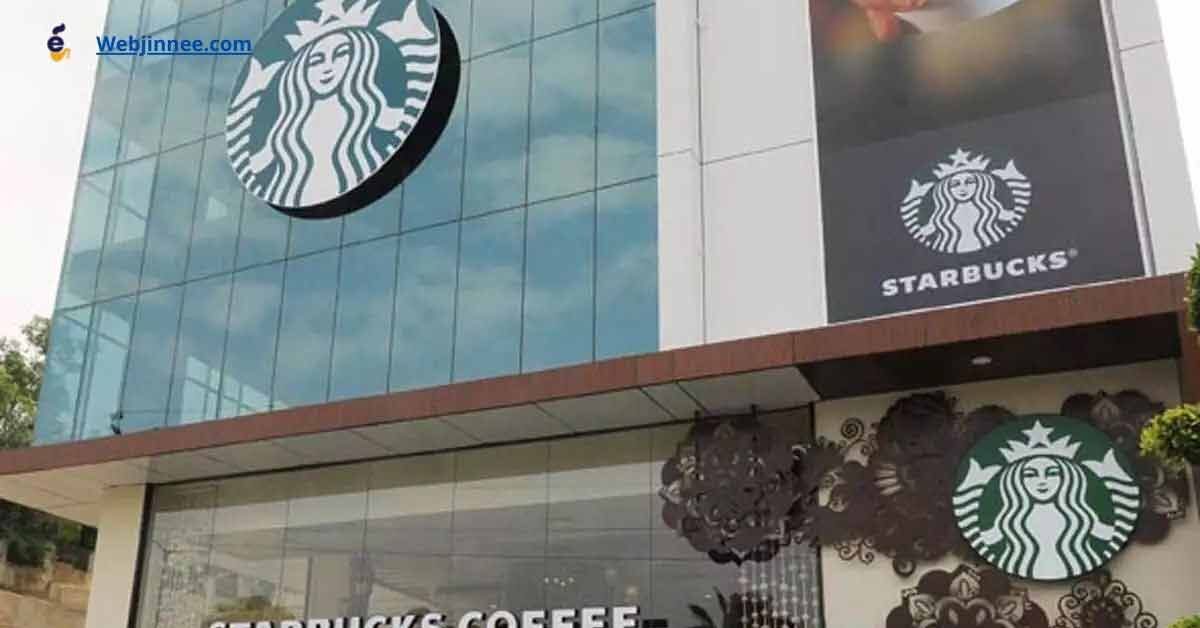
Is Starbucks a Success in India?
Starbucks wanted to enter the Indian market in the 2010s. Starbucks wanted to capitalize upon the rising popularity of coffee culture in India by targeting the upper-class segment.
It announced its entry into India in 2007 but pulled out without explanation. In 2011, Starbucks made its grand entrance into India.
The world’s largest bistro chain sought to enter India’s market. They entered into a 50-50 joint venture agreement with Asia’s largest coffee producer , Tata Consumer Products Limited.
After launching their brand successfully, it was important to identify their target audience.
Who Is Starbucks' Target Audience in India?
Starbucks is a premium coffee brand. Its customers are mostly from the upper-income segment, the upper-middle class, and the upper classes.
People are looking for a quiet place to enjoy coffee and reduce stress. These people are typically the highest-earning, high-skilled professionals and business owners.
People who live a busy lifestyle need good coffee and a place to unwind after a long day. Starbucks provides all of these benefits in one place.
Starbucks targets both male and female customers. A large number of them are between the ages of 25 and 45 . Target audience of Starbucks is mainly urban, health-conscious, and class-conscious customers.
The company knows exactly who its target audience is at any given moment and has gone to great lengths to serve them.
Their target audience can be summarized as-
- High-income spenders
- Urban chic, always on the move
- Technology early adopters
- Health-conscious professionals
- Flexibility to adapt
- Reach beyond the storefront
Let’s now look at their business and understand the foundation of Starbucks. Then let’s discover the marketing strategies that made Starbucks the global giant today.
You May also Like:- 9 Best Laptops for Blogging (Affordable Price)
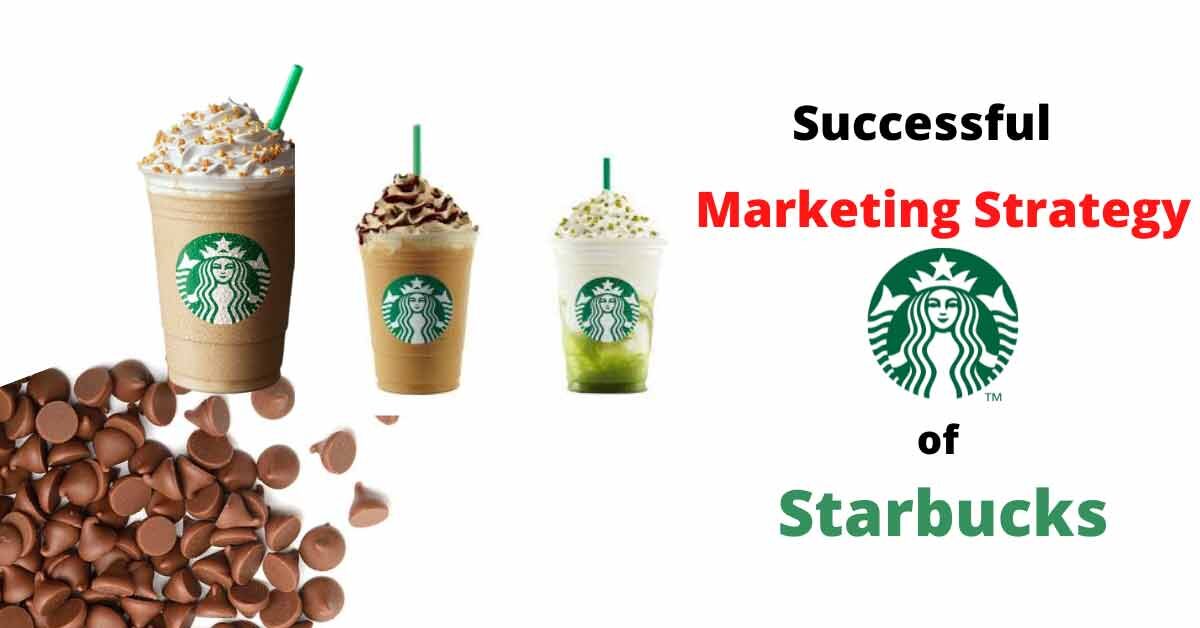
What is the Successful Marketing Strategy of Starbucks?
In India, Starbucks’ initial marketing mix was based on segmenting consumers socio-economically. Focusing on professionals who need a relaxing environment.
Starbucks segments its market by establishing stores in areas where it can reach the demographic and geographic target audiences.
Companies tend to focus on one segment when they enter new markets. If they succeed, they expand into other segments.
Starbucks followed the same approach and catered to teens and young adults by expanding its product line and social media presence.
Starbucks’ marketing strategy has allowed them to establish a unique market position. It’s all about the brand’s differentiated experience. They are a well-respected brand.
To reach today’s tech-savvy generation, the company’s marketing mix has increased the use of digital technology and social media to promote the brand and engage customers.
You May also Like:- 7 Best WordPress Hosting In India
Digital Expansion
Starbucks is focusing on expanding its digital interaction with customers. Starbucks is looking for new ways to reach digitally registered customers beyond its rewards program.
The coffee chain offers mobile ordering services and leverages Wi-Fi sign-ins at brick-and-mortar shops.
Starbucks Social Media Strategy
Many people are familiarized with Starbucks via social media. Starbucks’ social media accounts are well-known for their unique branding, interactive posts and visually appealing content.
There are many content options, including articles, photos, and features. There’s much more to the content than meets your eye.
You can break down the content into campaigns that aim to increase brand awareness and build community.
Starbucks Product-Based Marketing Campaigns
Starbucks is known for promoting fan-favorite drinks and unique products. They know how popular their flagship products are, but they also know that their customers crave this type of content.
They even have social accounts for their favorite products -Pumpkin Spiced Latte and Frappuccino – to share relevant memes with loyal customers.
User-generated content (UGC) is another option. Images of most Instagram-worthy consumers, such as Unicorn Frappuccino, are often re-shared on the official channels. They also get used in influencer campaigns.
You May also Like:- Why is it Important to Reach Customers on their Mobiles when Advertising locally ?
Community-based Campaigns of Coffee Giant
#redcupart campaign.
Starbucks’ digital strategy also emphasizes individuals and their communities. They use storytelling to highlight acts of kindness and courage in American communities.
Starbucks makes conscious efforts to humanize its company. They share stories on their Instagram account, highlighting employees who play a vital role in securing trust for big brands.
This social aspect makes online coffee content more social than ever, much like how Starbucks invented modern coffeehouse culture.
Festive Marketing
#Starbucks Diwali Blend, for their consumers across the country and select global markets. This new blend was hand-picked from Tata Estates in Karnataka, Tamil Nadu. Starbucks Diwali Blend was created to honor the region’s rich cultural and coffee expertise.
It launched the #SketchTheBlend campaign , where customers can share their creativity on the Diwali blend cup and sleeves and win 5 free drinks.
We can fully understand the different strategies that contribute to their high-quality marketing. Let’s dig deeper to analyze their digital presence.
Starbucks Corporate Social Responsibility Campaign
Starbucks uses social change to market itself as inclusive and open-minded. The #ExtraShotOfPride campaign supports LGBT+ communities.
What is the Controversy with Starbucks?
Starbucks suppports #black lives matter.
After receiving criticism, including calls for a boycott of the coffee brand, Starbucks has backtracked on its policy banning store employees from wearing their own Black Lives Matter clothes and accessories.
Additionally, Starbucks Distribute clothing and badges in support of other potentially controversial topics including same-sex marriage and LGBTQ rights.
"Pig" Controversy of Starbucks
On Thanksgiving Day, a police officer placed an order for five coffees, but when they arrived, he noticed that the barista had printed “Pig” on each of the five labels.
The coffee shop manager expressed regret and offered to have the labels printed again, but the chief wasn’t happy with that approach and posted his account on Facebook.
Starbucks Stole Unicorn Drink
In 2017, Starbucks introduced a new item to their menu called the Unicorn Frappuccino, and a cafe claimed that Starbucks had stolen its “Unicorn Latte,” a health-conscious drink.
Starbucks is allegedly selling unicorn, which is Cafe’s trademark drink, with milk and artificial sugars. The coffeehouse demands compensation and an official apology.

How does Starbucks use Digital Marketing?
Starbucks is well aware of its technologically advanced audience, making it crucial for them to develop a strong digital marketing strategy.
Starbucks prefers to market on platforms that allow two-way communication over platforms such as print and television, which are more one-way.
- Instagram – 248K+ Followers
- Facebook – 1.1M+ Likes
- Twitter – 161K+ Followers
- Starbucks updates its social media accounts daily and creates challenges and games to engage customers and grow its fan base.
- All platforms have the same engagement and posts. We believe that this creates an experience rather than just a channel for promotion.
The Flipkart Starbucks Twitter Battle was a great example of how active and social a brand can be. It shows why Starbucks is so popular with its target audience, particularly millennials.
They also post images of family members enjoying Starbucks coffee with friends and high-quality content that promotes seasonal products. Starbucks is now integrated into the social lives of its customers by doing this.
You May also Like:- Why did Danone fail in India?
Starbucks Marketing Strategy During Covid-19?
All of us are aware of the sudden devastation caused by the Covid-19 pandemic. Globally, all businesses were affected by the Covid-19 pandemic.
They had to find ways to survive in such difficult times. Although the pandemic had a severe impact on the Indian market, Starbucks was able to adapt its strategies to minimize the negative economic effects.
These are the steps that Starbucks took during the pandemic, which is a great example of why they’re the most valuable.
Why is Starbucks expanding in India?
Navin Gurnaney, a CEO, announced that they would be launching drive-thrus to encourage people to interact with them and home delivery to ensure they stay connected with their customers during this pandemic.
Ambala Chandigarh Expressway, Zirakpur, was the first drive-thru. Starbucks India has also launched an app called Starbucks India App, allowing customers to navigate the site and buy their products easily.
You May also Like:- Mother Dairy: A Delicious Case Study (360° View)
Starbucks Social Media Campaigns
Starbucks launched its social media campaign in two phases. The first phase was where they asked their customers to share their ways of reconnecting amidst the pandemic and share their favorite Starbucks memory on their personal Instagram handles with the hashtag
#ReconnectWithStarbucks Campaign
The second phase, “Half Cup Full”, asked customers to leave comments on their favourite beverage. These customers were then sent voice notes by baristas, who holler their names and favorite beverage to remind them about the in-store experience.
This campaign was great because it reminded people of their good times with Starbucks and made them feel valued and important.
#StarbucksAtHome & #StarbucksDance
Starbucks introduced 1 Liter of freshly brewed beverages, which could be ordered through Swiggy or Zomato. 7 flavors were available at Rs.550 each.
Starbucks created the #StarbucksDance challenge to encourage the same. It asked customers to create a dance video using the beverage and upload it to their stories. The winner would receive a year’s worth of Starbucks coffee.
Strategic Alliances for Enhancing the Experience and Reaching
Flipkart launches signature merchandise.
The pandemic caused a shift in the way people shop. It also encouraged them to shop for locally-grown products rather than imported or foreign-based.
This shift allowed Starbucks to partner with Flipkart to launch Starbucks Signature Merchandise online. This product line included custom mugs and tumblers as well as cold cups.
Customers will soon be able to order their coffee-brewing equipment online. Starbucks was only present in 12 cities. This strategic move was made to reach customers across India from their homes during the pandemic.
It also took advantage of India’s growing dependence on E-Commerce.
Standup Comedy Festival
Starbucks recently announced the #StarbucksComedyFestival, where a few lucky customers can win a free invitation to the comedy festival.
The customer’s invoice will contain the lucky codes. Clients will be more inclined to shop at Starbucks with hosts such as Rahul Subramanian and Azeem Banatwalla.
You May also Like:- What is Hyperlocal? A Game Changer Business Model
Popular products of Starbucks Corporation?
Vanilla Latte
Hot Chocolate
Iced Matcha Tea Latte
Cinnamon Roll Frappuccino® Blended Coffee
Pumpkin Spice Latte
Caramel Frappuccino
What is the Starbucks' Marketing Strategy?
Starbucks was founded in Seattle in 1971. It quickly gained popularity for its high-quality whole bean coffee and fast service. The company has been focused on a brand-centric marketing strategy since its inception.
It strives to create and maintain a distinctive identity around its customer service, comfortable in-store environment, sustainable coffee, and optimal customer service.
Starbucks is achieving this important marketing goal by championing social media marketing and consistently delivering a digital campaign that engages existing and new customers. in fact, these campaigns often utilize user-generated material, which transforms buyers into brand ambassadors.
Starbucks is unique amongst its competitors in that it does not invest heavily in offline promotion. Instead, its promotional communication is primarily limited to print and television.
Instead, the brand invests more in in-store features that enhance customer experience and satisfaction. This strategy is working, reporting revenues exceeding $26.5 billion and profit of $3.6 billion in the fiscal year 2019.
You May also Like:- The 65 Best Free Affiliate Marketing Tools to Boost Sales (2022)
Business Growth Of Starbucks in Recent Years?
Starbucks has multiple business growth strategies to take advantage of the huge growth potential in the global market. Starbucks focuses on expanding its international market presence and offering high-quality, value-added products. Starbucks adapts the mix of these intensive growth strategies to the current market conditions.
Market Penetration
Market penetration is Starbucks Coffee’s primary strategy for intensive growth. This strategy, known as the Ansoff Matrix or market expansion grid, supports Starbucks Coffee’s intensive growth.
It maximizes revenues from existing markets by using the same or similar food and beverage products. Starbucks is already present in more than 78 countries.
The company uses market penetration to increase revenues and grow in these markets by opening more company-owned shops or licensed/franchised café locations.
Starbucks, for example, aims to open more shops in countries with a low presence, such as Africa and the Middle East. The company must overcome the regulatory and socio-cultural hurdles in these coffee markets.
Starbucks’s Marketing mix of 4Ps supports the market penetration intensive growth strategy. This is especially important for expanding the company’s reach through promotions and strategic locations.
Market Development
Starbucks uses Market Development as its secondary strategy to intensify growth. This strategy helps to support business growth by creating new markets or new market segments and offering current products, such as food and beverages.
Starbucks Coffee, for example, offers its products to more customers by expanding into new markets, such as Africa and the Middle East.
Strategically growing the company’s customer base is a key strategy to maximize market opportunities. This results in a higher volume of food, beverages, and other merchandise sales.
Product Development
Product development is another strategy for secondary intensive growth. It helps Starbucks Corporation grow by creating new products and variants that increase business revenues.
The company, for example, offers ready-to-drink and brewing equipment. Mergers and acquisitions can also lead to product development, as Starbucks did when it started selling Frappuccino after purchasing The Coffee Connection. New products are considered a way to increase sales revenue, particularly in saturated coffeehouse markets.
Starbucks Corporation’s SWOT analysis reveals that the company’s ability to create profitable and attractive products is one of its business strengths. This supports the company’s intense growth and strategic expansion in global markets.
You May also Like:- Umbrella Branding: A Researched Marketing Strategy
Starbucks’ dominance in the global market and its leadership make it the leader. Starbucks is undoubtedly a unique coffee shop experience. It offers a warm, inviting environment and unparalleled service.
Starbucks’s retail locations and on-site partnerships have attracted greater responses, making it the mature sector’s market leader. Starbucks has a strong market position due to its comprehensive marketing strategy.
Follow Webjinnee on:-
Leave a comment cancel reply.
Save my name, email, and website in this browser for the next time I comment.
About webjinnee
The 65 Best Free Affiliate Marketing Tools to Boost Sales (2024)
79 diwali social media campaigns from top brands with powerful message, join us it's free.


Ecommerce Personalization Blog
Ecommerce tips, strategies, and news – all without ever having, [case study] how starbucks omnichannel drives repeat sales.
As we get closer to 2024, omnichannel retailing is becoming table stakes for eCommerce and traditional brick and mortar alike. Starbucks omnichannel strategy is a great case study in how to deepen customer relationships and drive repeat pruchases. Their success with omnichannel retailing provides a playbook of successful omnichannel tactics.
Each section will first look at specific strategies and tactics Starbucks is using today. Then, we will draw specific action steps eCommerce stores should take.
How Starbucks Omnichannel Strategy Drives Channel Expansion
In 2018, Starbucks had a problem.
While their most loyal group of customers were actively enrolled in Starbucks Rewards, that left 60 million customers a month who had no digital relationship with the brand at all.
Once identified, establishing a digital relationship with these customers became the cornerstone for expanding Starbuck's omnichannel retailing strategy.
1. Create Incentives and Force Channel Adoption
In March 2018 , the company decided to gate free wi-fi.
In order to access the internet, customers first had to register with an email address. In other words, they forced a digital relationship, gaining permission to contact customers via a new channel (email) in exchange for access to free wi-fi.
Internally, customers who have inputted their email but have yet to sign up for Starbucks Rewards (SR) are called "digitally registered customers".

Since creating this category, they've added 10 million digitally registered customers to their database. In their last earnings call, Executive Vice President & Global Chief Strategy Officer Matthew Ryan shared how they view this relationship: “We have to think of it (digitally registered customers) as the top of the funnel; an enabler of the relationships that we can create that lead people eventually into the Starbucks Rewards Program. Later , we’ll explore exactly how Starbucks executes this funnel. But first, I want to draw a few lessons that large eCommerce stores should consider.
We have to think of it (digitally registered customers) as the top of the funnel; an enabler of the relationships that we can create that lead people eventually into the Starbucks Rewards Program. - Matthew Ryan, Executive Vice President & Global Chief Strategy Officer, Starbucks
2. Reward customer loyalty with unique offers and experiences
We see the vision playout in Starbuck's triggered email campaigns. Many offers require customers to be enrolled in Starbucks Rewards. Below is a great example. As the ad says, "Starbucks Rewards members who use the app to order ahead a handcrafted beverage (grande or larger) get a coupon for a free drink redeemable 3/10-3/12. Sign up for Starbucks Rewards to get the offer."

Embodied in the offer is a series of important actions Starbucks wants their customers to take.
- Become a Rewards Member
- Utilize the Starbucks app to order ahead, part of their click and collect strategy
- Redeem in one week, to help further cement
Starbucks goes beyond unique offers for Rewards Members. They routinely create whole experiences for their customer base to take part in. Below is one example - their annual "Starbucks for Life" event. Reward Members can collect game pieces by purchasing select items. Rewards range from $500 gift cards, Bose Earbunds, and, as the name implies, Starbucks for Life!

3. Lessons for Ecommerce in Channel Adoption
Channel adoption is fundamental to omnichannel retailing.
It is worth incentivizing by whatever means possible.
Starbuck's playbook is simple. First, identify what your strongest customer touchpoint is and incentivize channel adoption with a clear benefit during that touchpoint. In their case, they already had 28,000 physical stores with 75 million monthly customers. They identified a key benefit, and parlayed that service into new customer relationships via email. For many eCommerce stores, their strongest customer touchpoint is online (their site). Barilliance equips you with a number of tools to convert site visitors into whichever channel makes the most sense for your business.
Some of our most popular features for doing this include:
- Unique Triggered Email Offers: The most effective email opt-in offers we've found in eCommerce are service related, such as email my cart and visit summary offers.
- Personalized Browse Abandonment: Most visitors never make it to your checkout pages. Personalized browse abandonment offers can convert visitors to email subscribers, and give you an opportunity to nurture a relationship overtime.
- FB Messenger: Message apps represent the fastest growing channel in eCommerce. The behemoth in the space is FB Messenger . Last year, we enabled clients to leverage this channel to significantly reduce cart abandonment. However, once you have permission, you can use this channel to drive repeat purchase.
- Onsite Personalization: Lastly, you can prompt visitors to opt-into any channel you want through personalized widgets. We have clients that use a variety of message bars, pop-ups, or dynamic content to transform visitors into email subscribers, social followers, or download their mobile app.
You can see an example of onsite personalization below.
To begin their omnichannel retail strategy , this client starts with a personalized offer, only seen by visitors who have not already submitted their email.
The offer is presented in the from of a sliding message bar.

Once a new visitor reveals interest by clicking on the bar, a pop-up is displayed.
In exchange for their email address, they will receive a 10% off code. In implementing these solutions, it is important that you control the user experience.
For example, this particular tactic isn't shown on mobile devices, nor to returning customers who they already have a relationship with. With Barilliance, you can easily define any number of segments to present unique offers to.

Whichever number of tactics you employ, you want to give a concrete, exclusive benefit to creating a continuous relationship with your brand. As we’ll see, establishing multiple channels as part of your own omnichannel retailing strategy will give you multiple ties to customers, allow you to gather more data on each client, and ultimately create personalized offers that increase order frequency and AOV.
How Starbucks Uses Omnichannel Retailing to Increase Repeat Purchases From New Channels
How do you capitlize on new customer relationships? As Matthew Ryan shares, “We’re not in the business of creating digital relationships for digital relationship’s sake. They’re an enabler for us to communicate and talk to our customers.”
We’re not in the business of creating digital relationships for digital relationship’s sake. They’re an enabler for us to communicate and talk to our customers. - Matthew Ryan
Starbucks uses these newly acquired email addresses to drive retention and purchase frequency .
While a variety of offers and communications are sent, two stand out. First, is a recurring flagship offer: Happy Hours. In this email, Starbucks sends a discount offer on a specific product category (such as teas, seasonal drinks, or frappuccinos). The offer is limited, often expiring same day and only available during certain timeframes. The goal is to drive digitally registered customers into stores during non-peak hours. Offers are geared toward premium products, serving as a gateway to more profitable skus.

Second, as alluded above, Starbucks views email as the first phase in their omnichannel retailing strategy. It is their first digital channel, not their last.
The ultimate goal of digitally registered customers is to motivate them to become a part of their Starbucks Rewards program.
Customers are given regular incentives to progress through the funnel. In the example below, they email an offer of a free drink when they create aSR account. The exact offers sent are personalized to the types of products a digitally registered customer has bought in the past.

Lessons for ECommerce in Driving Retention
How do you create value to justify a continued relationship with your brand? In Starbucks case, they use a combination of one time discounts and ongoing loyalty rewards to drive purchase frequency. They also focus on customer adoption of more premium offers. Barilliance has a number of ways to help eCommerce stores replicate these tactics.
Create a 360 View of Customers to Develop Understanding of Customer Preferences
To make effective offers, you need to be able to track customers across devices and shopping sessions. Barilliance tracks more than what products each customer has purchased.
- Product Affinity: Beyond products purchased, you want to track which category and product pages visitors interact with, as well as what on-site searches they make.
- Frequency: Barilliance tracks site visits. You can segment based on first visit, last visit, or number of visits - giving you the capability to define your own segments of first time visitors, returning lapsed visitors, those who are in threat to churn, VIP customers, or whatever segment makes most sense to your business.
- Demographic Data: Information such as location and device type are automatically recorded.
- Brand Engagement: Lastly, you want to be able to track customer engagement overtime, including if they've responded to past offers, and if you need to trigger a follow-up.

Use Big Data to Create Personalized Offers
Data without application is useless. Barilliance gives you the ability to use this data in a number of ways.
In the screenshot above, you see the backend of our Retention product. You can create any number of segments important to your business. We wrote up a whole post on six crucial segments for eCommerce businesses using RFM Analysis here .
Additionally, you can use demographic and product affinity data to personalize each email. You can restrict in-store offers to those that are within the same city, or restrict free shipping to certain areas.
My favorite examples incorporate our product recommendation engine.
You can see a break down on how our personalized recommendations outperform standard recommendation widgets here, increasing CTR by 289% and conversion rate by 189%.

Next Steps...
The first step in creating your own successful omnichannel retailing strategy is to identify a technology partner.
You want a partner that is capable of:
- Unifying Customer Data: Collect and connect customer behavior, demographics, product/category affinities, and purchase history across all channels through a customer data platform .
- Cross-Device Continuity: Able to make a seamless, omnichannel experience across devices
- Segmentation Capabilities: Data is useless without the ability to analyze and take action. Your technology partner should equip you to identify high priority customer segments and create personalized offers to each.
- Personalization Capabilities: The strength of your partner's personalization capabilities will directly correlate to your ability to maximize opportunities.
To see if Barilliance is a good solution for you, schedule a demo here .
You Might Also Like

Improving your retention rate is a massive opportunity. This article breaks down successful retention strategies, includ

Building customer loyalty is a primary way to increase conversions and multiply profits. Below we explore two case studi
- © 2009 - 2024 Barilliance Ltd.
- Privacy Policy
- Terms of services
Marketing Sensorial: Estudo de Caso da Starbucks : Sensory Marketing: Starbucks Case Study
Ieee account.
- Change Username/Password
- Update Address
Purchase Details
- Payment Options
- Order History
- View Purchased Documents
Profile Information
- Communications Preferences
- Profession and Education
- Technical Interests
- US & Canada: +1 800 678 4333
- Worldwide: +1 732 981 0060
- Contact & Support
- About IEEE Xplore
- Accessibility
- Terms of Use
- Nondiscrimination Policy
- Privacy & Opting Out of Cookies
A not-for-profit organization, IEEE is the world's largest technical professional organization dedicated to advancing technology for the benefit of humanity. © Copyright 2024 IEEE - All rights reserved. Use of this web site signifies your agreement to the terms and conditions.
- Study Guides
- Homework Questions
1.9 Assessment Case study - Starbucks Hamna
Stay-at-home parents do thousands of dollars worth of tasks each month, study says

(CNN) - The workload of parents who stay home with their children has a pretty high value.
A new study by Beike Biotechnology looked at household and childcare tasks by stay-at-home parents for up to four children in 80 major cities worldwide.
It analyzed how much the parents’ labor would cost to outsource the chores such as cleaning, cooking, shopping, transportation, emotional support, tutoring and administrative tasks.
Of the 10 cities where stay-at-home parents of two were the most valuable, four were in the United States.
San Francisco was the highest-ranked American city. Researchers found a stay-at-home parent of two children in San Francisco does about $5,200 worth of tasks per month.
Washington D.C. was ranked 7th with $4,400 per month.
New York City was 8th with $4,300 per month.
Los Angeles was 9th with $4,200 per month to outsource the work of parents.
Copyright 2024 CNN Newsource. All rights reserved.

Pedestrian struck, killed by train in Lexington

AT&T phone service issues reported across Kentucky

Two people robbed outside Lexington restaurant

10-year-old boy confesses to killing a man in 2022

Loved ones honor fallen Central Kentucky police sergeant
Latest news.

Officer who won Rookie of the Year award dies in car crash

Propane tank explodes at Georgetown business

Pediatrician pleads guilty to hiring hitman to kill ex-husband

WATCH: Propane tank explodes at Georgetown business

WATCH: One person found dead after Berea fire
GRAPHIC: Case against mother accused of decapitating 6-year-old son, dog set to move forward
KANSAS CITY, Mo. ( KCTV /Gray News) - The case against a Kansas City mother who allegedly decapitated her son and her dog will move forward after she was found fit to stand trial.
According to court records from the 16th Circuit Court of Jackson County , on Friday, Judge Jerri Zhang granted a motion to proceed with the case against Tasha Haefs for the 2022 death of her 6-year-old son. Haefs has been deemed competent to proceed.
GRAPHIC WARNING: Details of the case are disturbing.
A warrant was issued for Haefs’ arrest in February 2022 after she allegedly decapitated her 6-year-old son, Karvel Stevens. She was later charged with first-degree murder and armed criminal action.
Court documents said police were called to Haefs’ home to check on her welfare. When they arrived, they found blood leading up to her front door and could hear a woman singing inside. As they knocked, the singing grew louder.
When an officer looked inside a window of the home, they said they could see part of a child’s body. They forced their way through the back door and found Haefs with blood on her legs and feet, as well as the rest of the boy’s body. A decapitated dog was also found in the basement.
Prosecutors said Haefs told detectives the body was that of her son and admitted to the killing. She had previously struggled with drug addiction, depression, severe trauma and hallucinations.
In June 2022, Haefs was ruled mentally unfit to stand trial, and the case was put on hold. Following Friday’s move, the state will be allowed to present evidence to a grand jury. A circuit court arraignment has been set for 2 p.m. on April 29.
Copyright 2024 KCTV via Gray Media Group, Inc. All rights reserved.

10-year-old boy confesses to killing a man in 2022

Parents charged after 1-month-old twin daughters found dead in crib

Stay-at-home parents do thousands of dollars worth of tasks each month, study says

‘Young and the Restless’ star Meg Bennett dead at 75

Casper College students celebrate cultural reconnection at campus powwow
Latest news.

Woman accused of calling her friends after she killed her husband, police say

Officer who won Rookie of the Year award dies in car crash

Pediatrician pleads guilty to hiring hitman to kill ex-husband

Trump tried to ‘corrupt’ the 2016 election, prosecutor alleges as hush money trial gets underway

Opening statements made in historic Trump trial

IMAGES
VIDEO
COMMENTS
In this case study, we will examine Starbucks' marketing strategy for 2024 and explore how the company has successfully built its brand, engaged with customers, and achieved global recognition. From product-based campaigns to corporate social responsibility initiatives, Starbucks utilizes various tactics to drive brand loyalty and expand its ...
Starbucks Corporation is an American multinational chain of coffeehouses and roastery reserves headquartered in Seattle, Washington. The company operates in over 30,000 locations in 70 countries worldwide as of early 2020. This blog is an in-depth analysis of Starbucks' marketing strategies, complete with touching upon their target market ...
Starbucks' Marketing Strategy. Founded in Seattle in 1971, Starbucks - one of the first US coffee house franchises at that time - quickly became known for the superior quality of its freshly-roasted, whole bean coffee. Since its establishment, the organisation has focused on a brand-centric marketing strategy, working to build and maintain ...
Decoding Starbucks' Marketing Strategy Success: Beyond the Coffee — Relevantly Facebook Marketing. Case Study. In an ever-evolving digital landscape, Starbucks stands out as a beacon of successful digital marketing. From its engaging social media presence to creative in-store experience, the Starbucks marketing strategy has continuously ...
Starbucks Corporation, an American company founded in 1971 in Seattle, WA, is a premier roaster, marketer and retailer of specialty coffee around world. Starbucks has about 182,000 employees across 19,767 company operated & licensed stores in 62 countries. Their product mix includes roasted and handcrafted high-
Learn about Starbucks' iconic marketing strategy and advertising campaigns. Read how Starbucks aces the 4Ps of marketing mix - Product, Price, Promotion & Placement. ... In this case study, we will dive into various aspects of Starbucks' marketing strategy. A brief history of Starbucks. Starbucks was founded by three men — Jerry Baldwin, Zev ...
Starbucks marketing strategy is a testament to the power of creating memorable customer experiences. By emphasizing uniqueness, sustainability, personalization, and embracing digital innovations, Starbucks has solidified its position as a global brand that extends far beyond coffee. To enhance your own business's marketing strategy, consider ...
The Starbucks marketing strategy constitutes a blend of social media marketing, digital marketing, search engine optimization, and right post-marketing analysis. Replicating the entire Starbucks marketing strategy is nearly impossible for brands with low budgets. However, learning and implementing the core principles and the idea behind the ...
We believe that Starbucks should seek to expand its international presence and revenue, so it's not overdependent on its U.S. consumers. Key words: Starbucks, Marketing Mix Strategies, Michael Porter's Five Forces, Case Analysis Introduction: The first Starbucks opened its doors on March 31, 1971, by three friends, Jerry Baldwin, Gordon
This blog conveys the complete Starbucks marketing case study, and with it, you will know how they use the 4Ps of marketing in their business to make its brand growth consistent. Marketing is a ...
2. Starbucks is undoubtedly one of the world's most identifiable brands - exhibiting an innovative and fresh approach to their brand and marketing strategy. The Starbucks Marketing Strategy has helped their brand reach epic heights thanks to their out-of-the-box campaigns and unmatchable commitment towards keeping their quality and brand ...
This marketing case study explores how Starbucks has successfully built and maintained its brand, engaged customers, and adapted to changing market dynamics. Background: Starbucks was founded in ...
Past studies have examined Starbucks in the area of customer loyalty (Pérez-Morón et al., 2022), marketing (Nair et al., 2021), business performance during the Covid-19 pandemic (Kee et al ...
The marketing mix identifies the main components of the coffee company's marketing plan, namely, product, place, promotion, and price (the four Ps). In this business analysis case, Starbucks uses its 4P to develop its brand image and ensure profitability. With the strongest brand in the coffeehouse industry, the company shows how an effective ...
Few recommend actions to boost short-term sales during promotion periods are listed below. 1. To maximize customer response: Collect data from existing members for a certain time period, determine customer-to-promotion category match for individual customers, and send single offers accordingly. 2.
Traditional Marketing Strategies of Starbucks. 1. The Red Cup Campaign: Every year during the holiday season, Starbucks introduces its iconic red cups with different designs and messages. The campaign aims to create a festive mood and celebrate the spirit of giving.
Profits (2023) $25.108 billion. Case Study of Starbucks: Business Perspective. In today's date, the coffee giant is flexing a market capitalization of a whopping $105.82 billion - that's some serious coffee beans. Now, rewind to 2023, and Starbucks made it rain with a revenue of $35.976 billion.
_____ The Siren's Lure - A Starbucks Influencer Marketing Case Study How and why does the famous coffee brand engage influencers? Written by Martine Mussies Frappuccino dominating selfies on Instagram, vlogs about pumpkin spiced lattes, and weblog posts as "Review of Starbucks' Orange/Mango Blend" — Starbucks fills social media like ...
Starbucks Case Study. Starbucks Corporation is an American coffee chain that was established in 1971 in Seattle, Washington. By mid-2019, the organization had a presence in over 30,000 areas around the world. Starbucks has been depicted as the fundamental delegate of "second wave espresso," a reflectively-named development that advanced high-quality espresso and specially simmered coffee.
The company launched its Starbucks Reserve program in 2010 for single-origin coffees, high-end coffee shops and premium coffees. It was planning to open 1,000+ Reserve coffee shops before 2020. Starbucks has six roasteries that offer tasting rooms and 43 coffee bars. Let's now see how Starbucks has made a name for itself in India.
Starbucks was the darling brand with steady growth through the 1990s. New brand fans every day. Around 2003, Starbucks started to lose their focus, and their results started to wobble. By 2008, they were facing a situational crisis. Our Starbucks case study outlines what they did to turn it around.
As we get closer to 2024, omnichannel retailing is becoming table stakes for eCommerce and traditional brick and mortar alike. Starbucks omnichannel strategy is a great case study in how to deepen customer relationships and drive repeat pruchases. Their success with omnichannel retailing provides a playbook of successful omnichannel tactics.
Marketing Sensorial: Estudo de Caso da Starbucks : Sensory Marketing: Starbucks Case Study Abstract: The rapid development of markets with competitive products, which are difficult to differentiate, and more informed consumers, who demand memorable experiences, justifies the study of sensory elements that can positively influence these ...
Marketing. 1.9 Assessment: Case study -Starbucks 1.What is Starbucks' growth strategy? . Starbucks' growth strategy involves a combination of opening new stores, both domestically and internationally, and expanding its product offerings beyond coffee. The company seeks to create a unique store experience and build customer loyalty through ...
Researchers found a stay-at-home parent of two children in San Francisco does about $5,200 worth of tasks per month. Washington D.C. was ranked 7th with $4,400 per month. New York City was 8th ...
A U.S. district court judge granted the injunction and the 6th U.S. Circuit Court of Appeals upheld the decision. However, Starbucks has said the workers were fired for violating company policy when they invited local journalists into a closed store. The company appealed the case to the Supreme Court. "So Starbucks is asking the Supreme Court ...
KANSAS CITY, Mo. (KCTV/Gray News) - The case against a Kansas City mother who allegedly decapitated her son and her dog will move forward after she was found fit to stand trial.According to court records from the 16th Circuit Court of Jackson County, on Friday, Judge Jerri Zhang granted a motion to proceed with the case against Tasha Haefs for the 2022 death of her 6-year-old son.